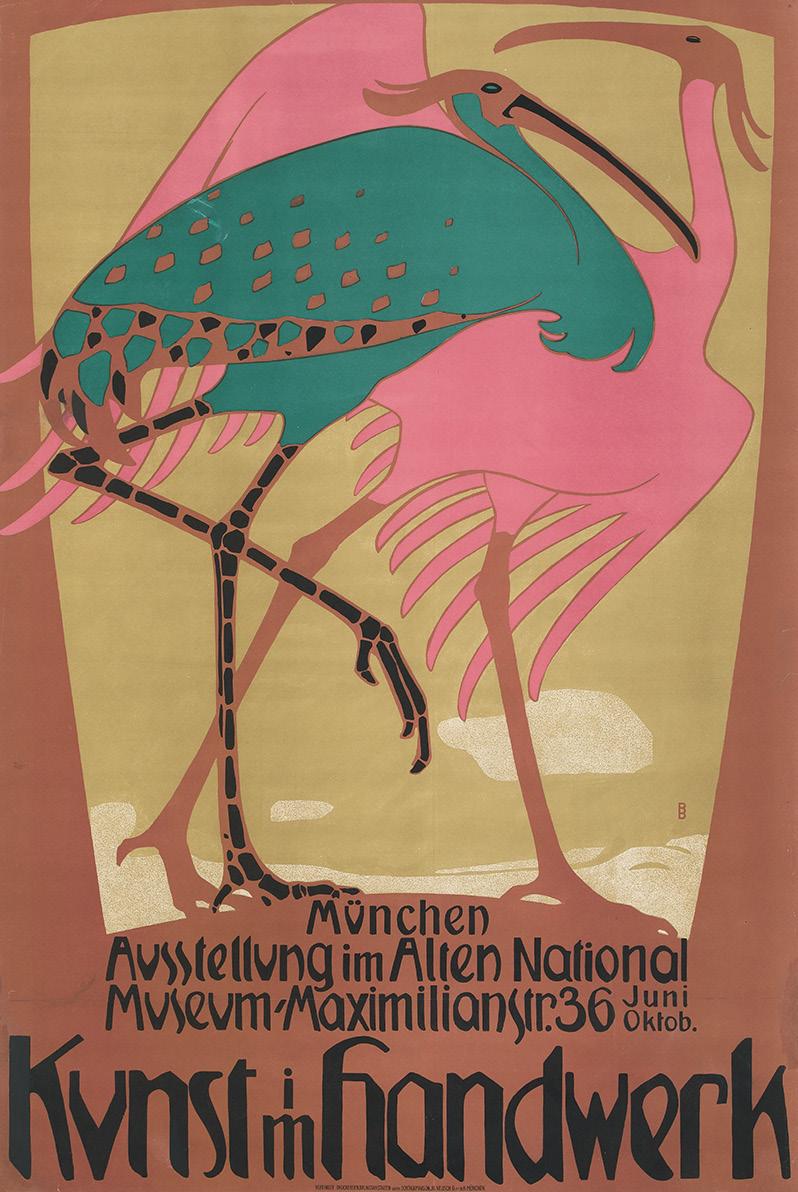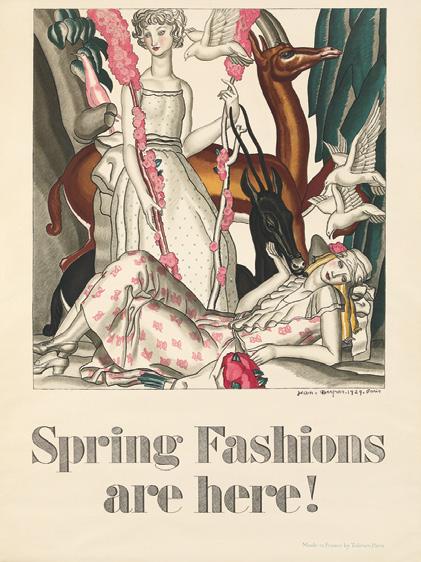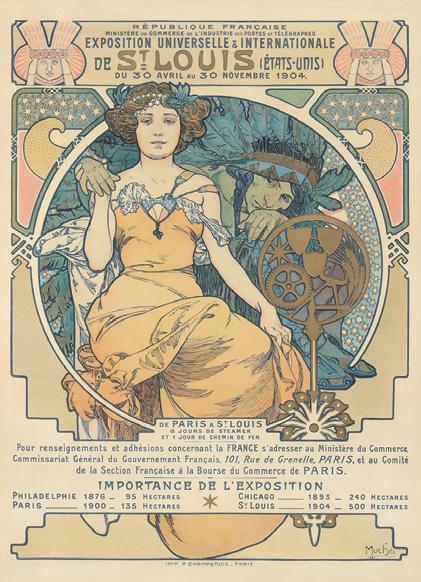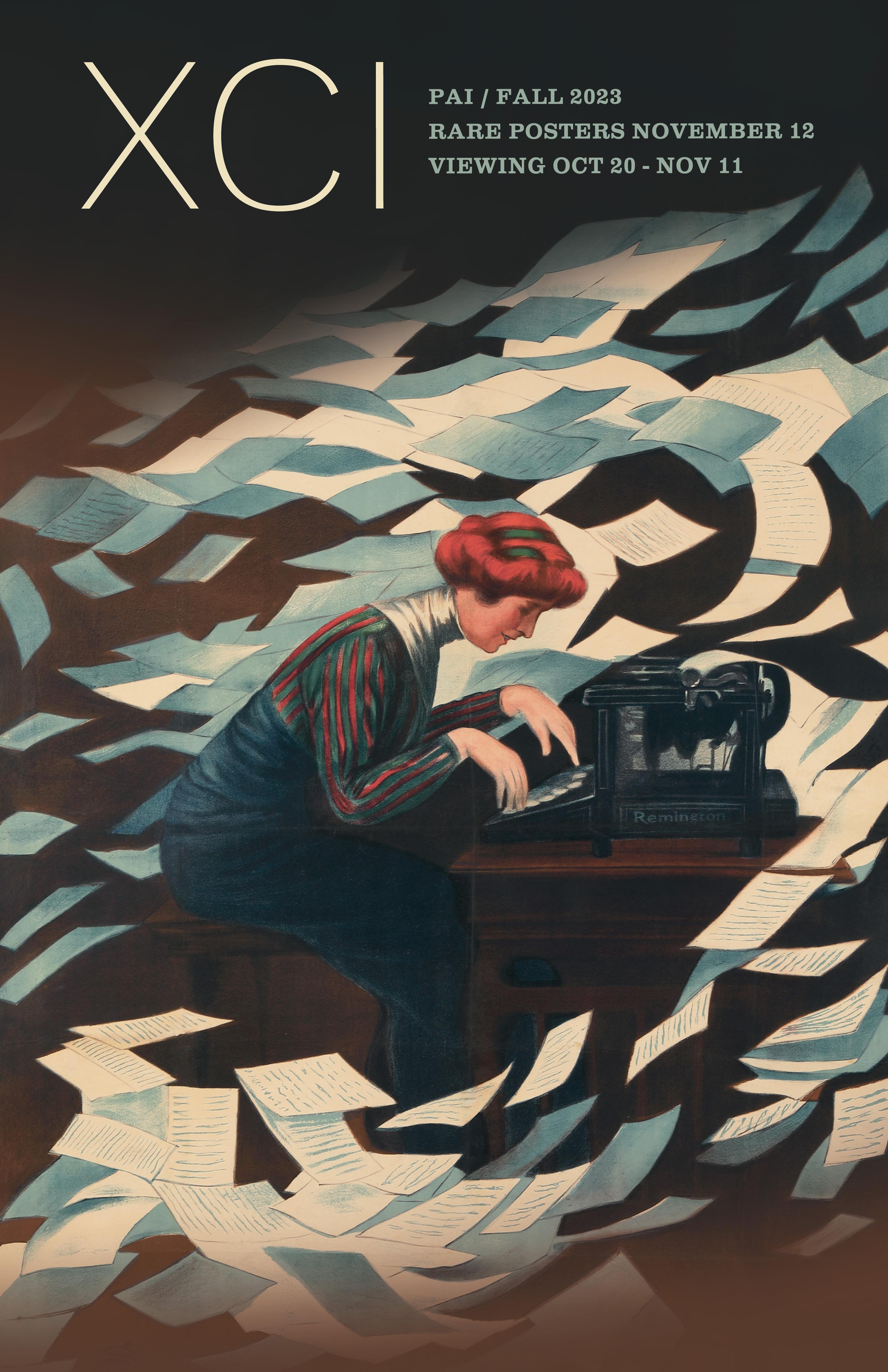
David Dellepiane’s
Exposition International d’Électricité. 1908.
Est: $12,000-$15,000
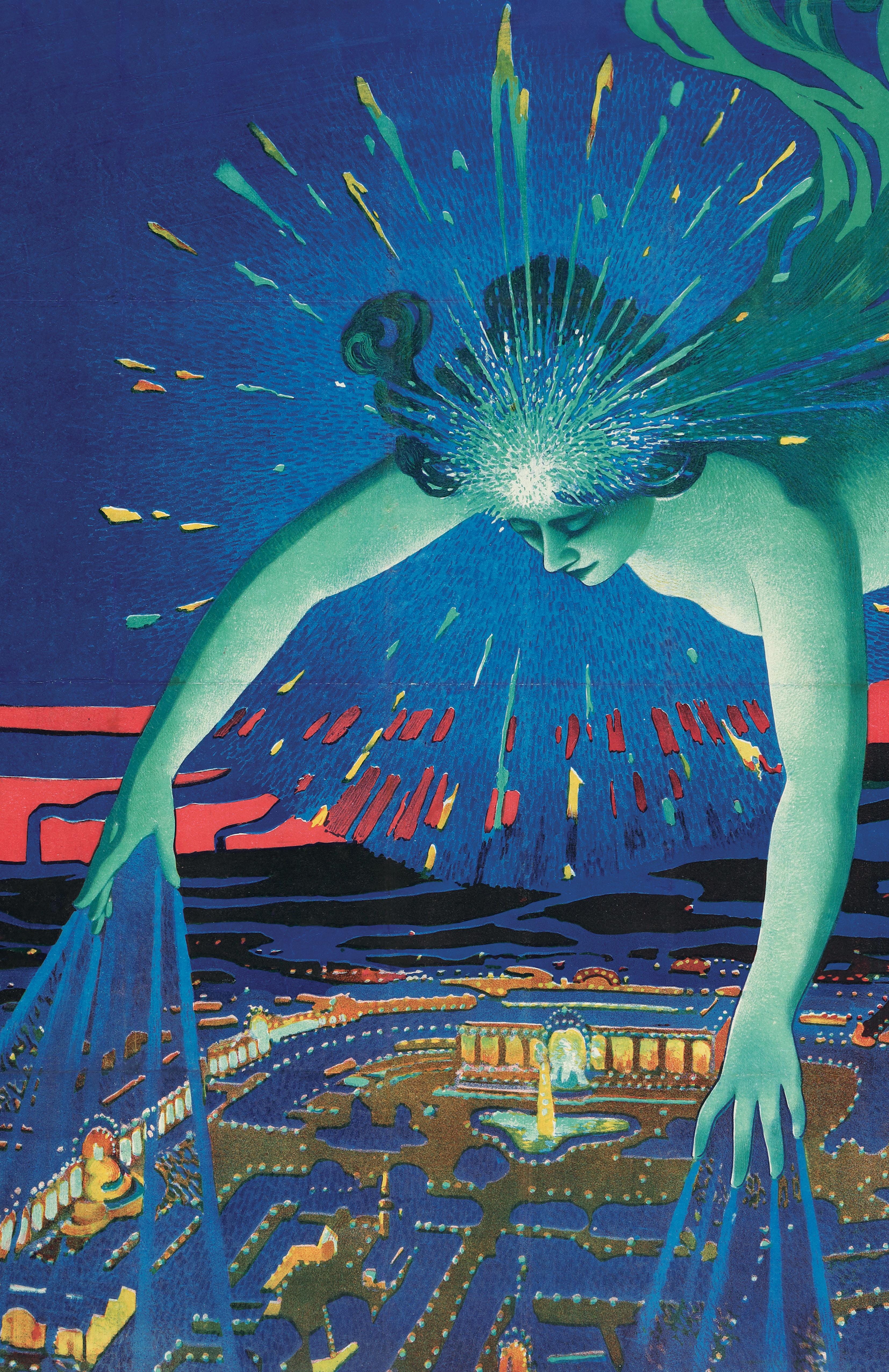
DEAR FRIENDS:
I am pleased to announce our 91st Rare Posters Auction.
This sale will include the quality and variety of posters that collectors expect from us: the 450 lots feature the best and rarest works of Broders, Cappiello, Chéret, Colin, Hohlwein, Mucha, Purvis, Schnackenberg, and Toulouse-Lautrec, as well as fine designs for bicycles, automobiles, aviation, Buffalo Bill, and War & Propaganda.
Notably, this auction marks some changes from our traditions. It has been our greatest pleasure to be one of the last poster auction houses to provide a printed catalogue, but we are finally adapting to the digital world, and have made the decision to provide the catalogue online only. The digital catalogue will continue to provide the contextual information and research that our printed books have always prioritized. In fact, all lots may now be viewed on our website. And if you’re in or coming to New York, do see them all at our gallery daily through November 11.
Additionally, in keeping with our colleagues, we are increasing our buyer’s premium from 20% to 25% on all bidding platforms. We hope you will understand the necessity of these modifications as we adapt to today’s auction house standards and needs.
As always, we are so grateful for your support and involvement in our auctions, and we are always here if you have any questions or need assistance. We look forward to seeing you at our next sale.
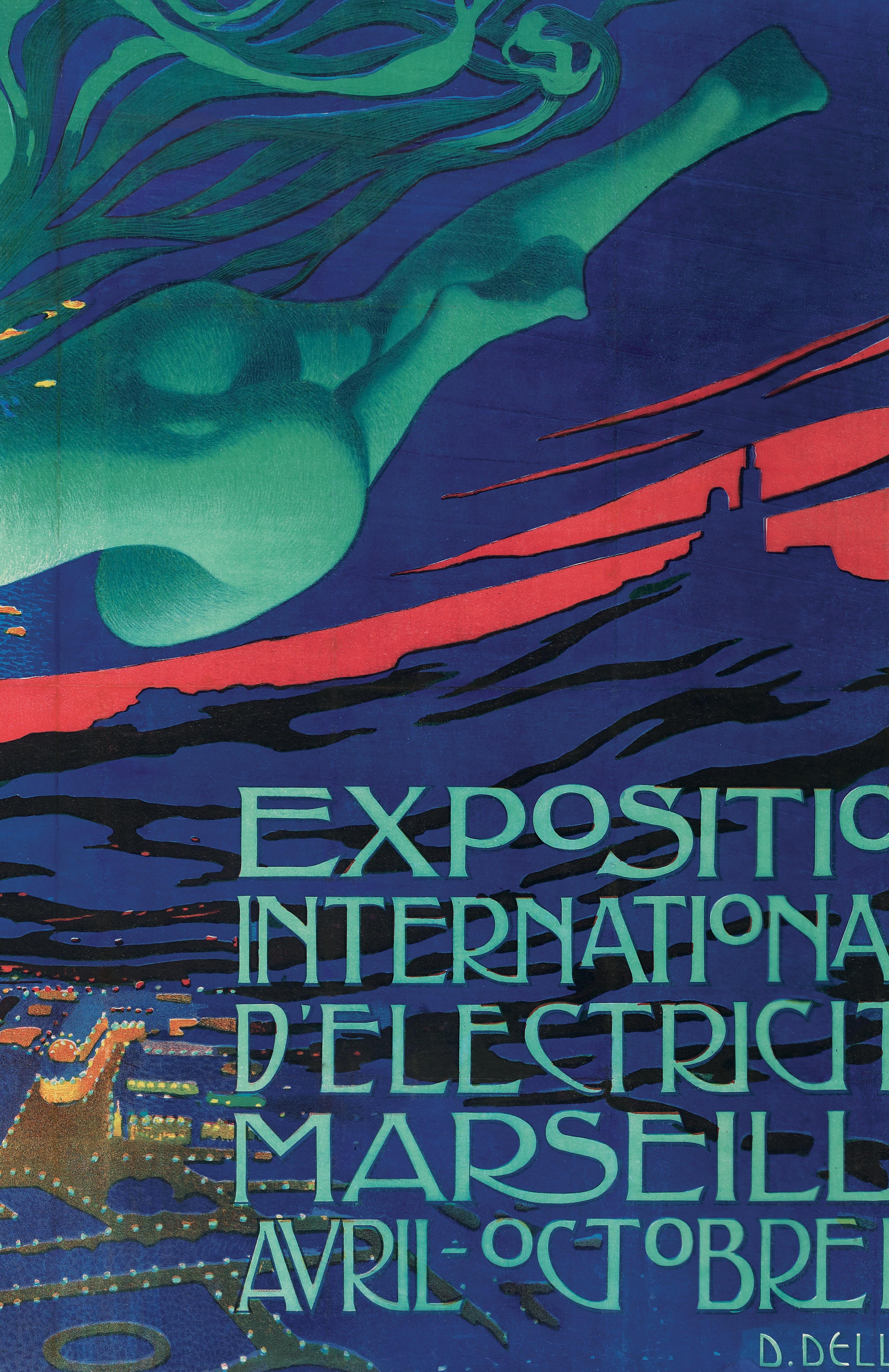
Jack Rennert
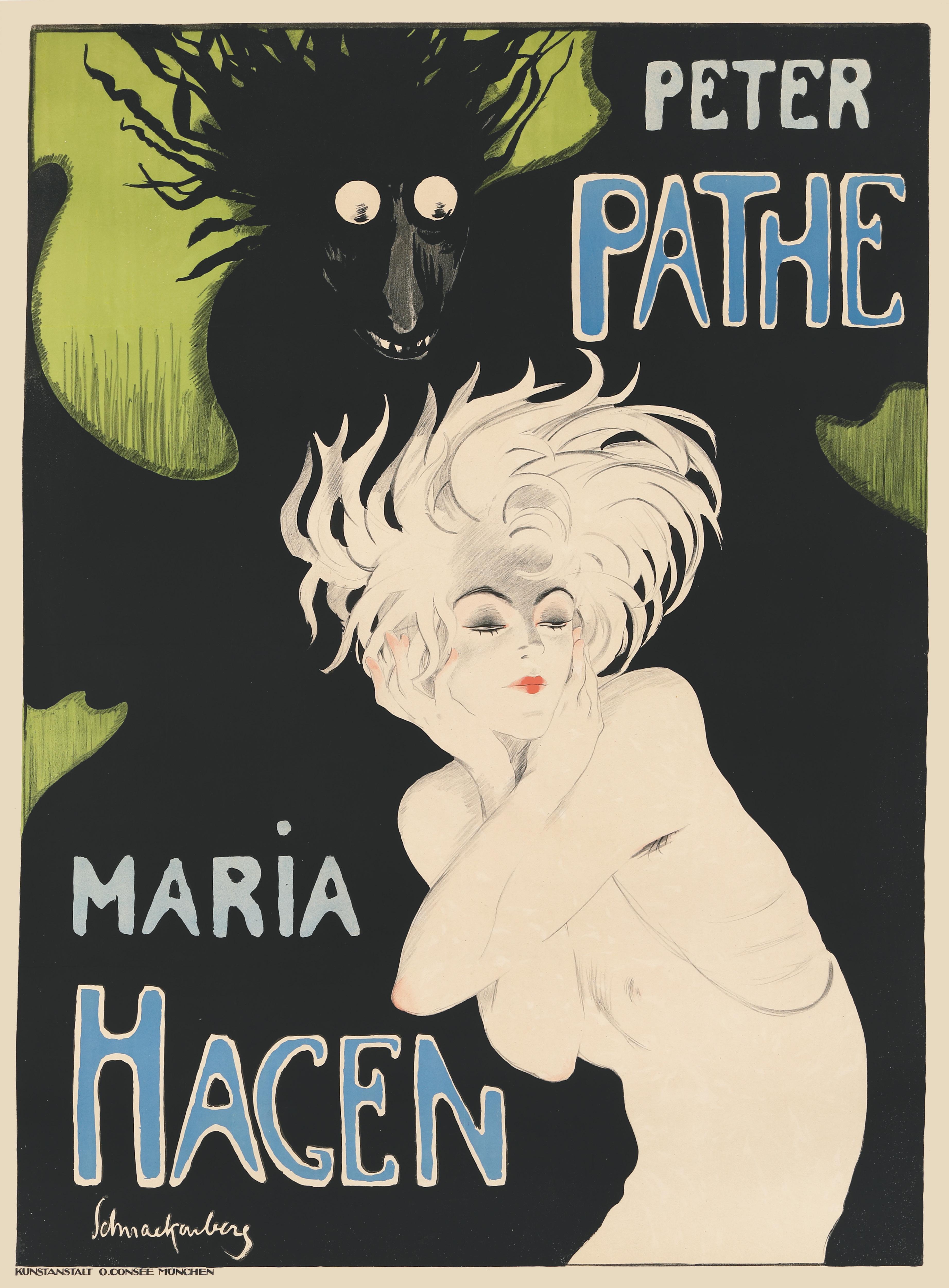
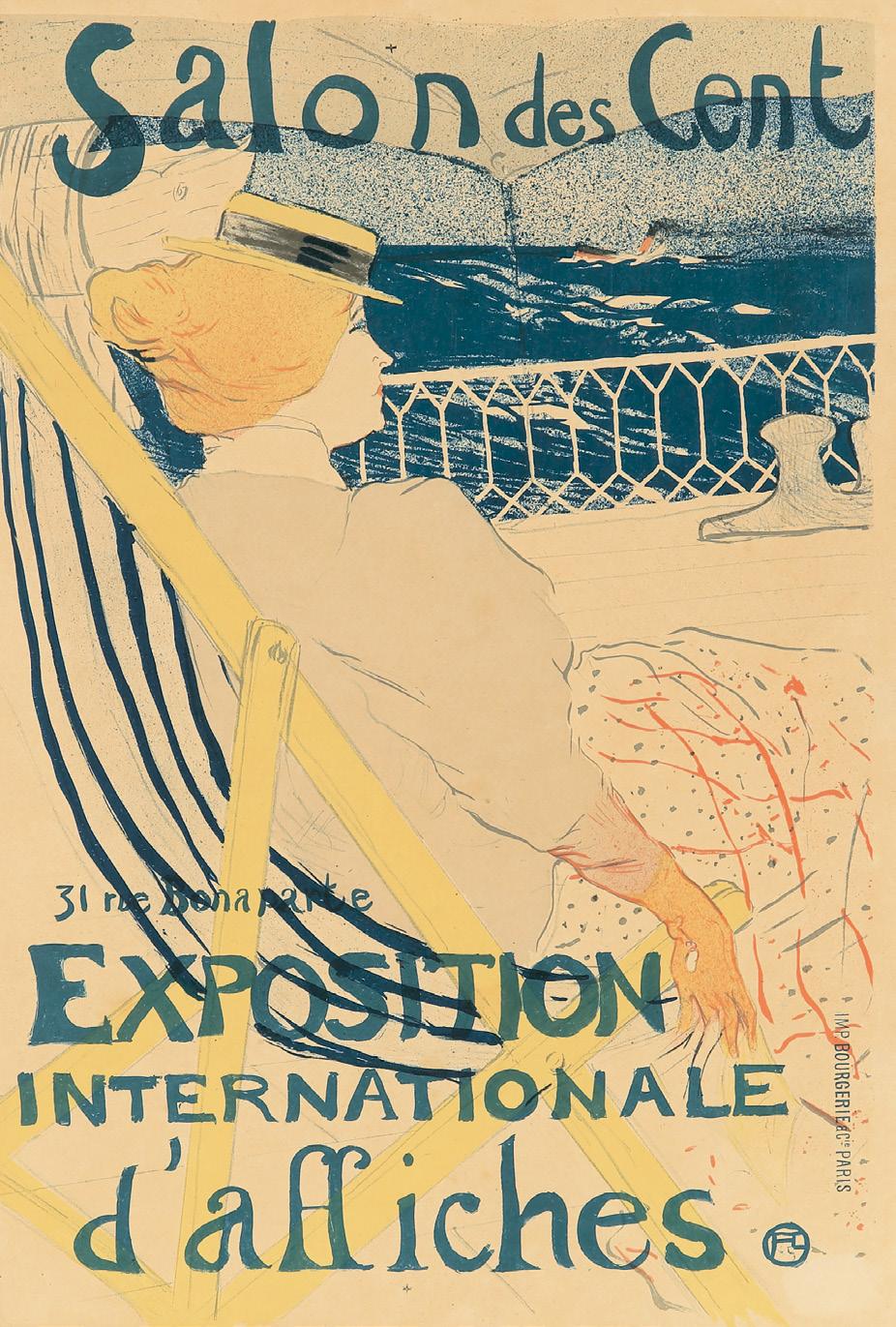
HENRI DE TOULOUSE-LAUTREC
Salon des Cent. 1896.
Summer, 1895. Lautrec and fellow artist Maurice Guibert are on board the steamer Le Chili , en route along the Atlantic coast from Le Havre to Bordeaux. Lautrec cannot keep his eyes off the young woman berthed in cabin No. 54. Lautrec, suddenly obsessed, ignoring pleas from Guibert, refuses to get off the boat at Bordeaux. Finally, he is persuaded off the boat at Lisbon. But not before he’s captured a photograph of the unknown woman, which he turned into a lithograph of the exact same pose, “exquisite both in its execution and in the remoteness of the subject’s personality” (Wagner, p. 31).
Est: $20,000-$25,000
Further highlights: Troupe de Mlle Églantine, La Loge au Mascaron Doré, May Belfort, Babylone d’Allemagne, Jane Avril, Au Concert, and Partie de Campagne
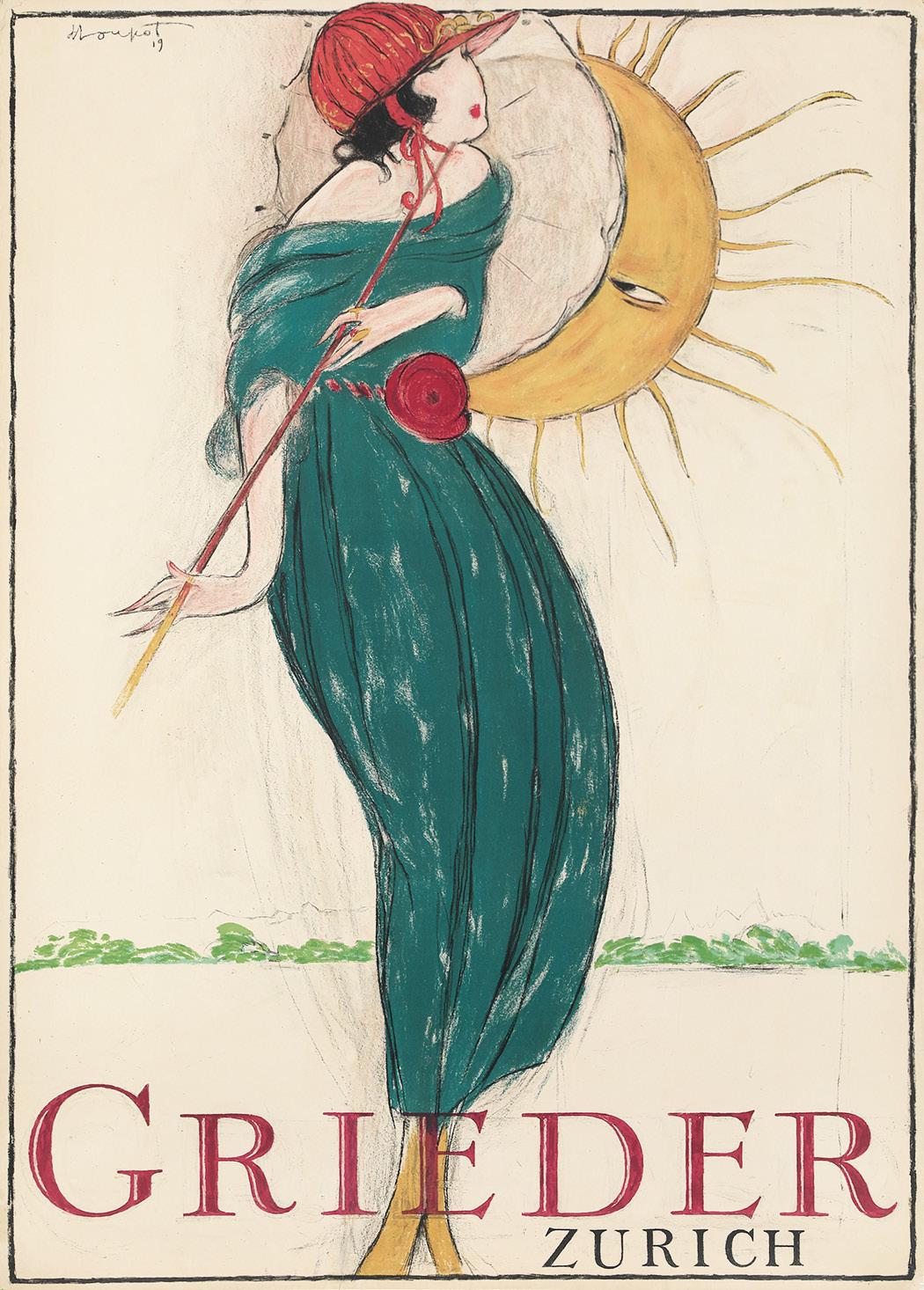
CHARLES LOUPOT
Grieder. 1919.
A famous fabric and clothing merchant in Zurich, Grieder frequently commissioned top poster artists to create lavish images for their seasonal offerings. The company repeatedly used the services of Loupot, as he perfectly captured the decadent nature of the product. Here, an ivory-skinned lady hides behind her delicate parasol as the sun sneaks a glimpse of her sensuous summer attire.
Est: $20,000-$25,000
Further highlights: Fourrures Canton and Malacéïne : Maquette
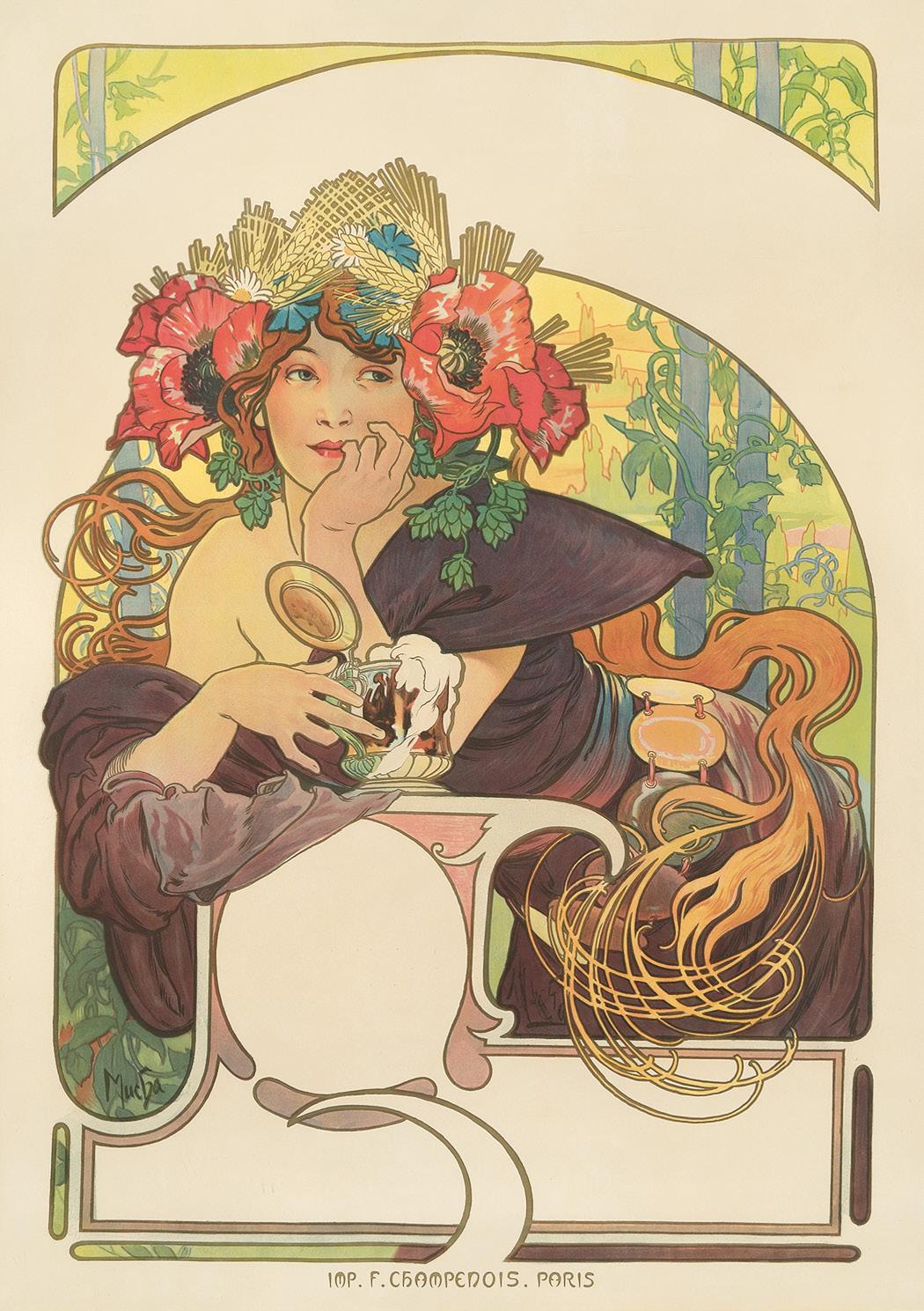
ALPHONSE MUCHA
Bières de la Meuse. 1897.
“The jovial beer drinker has her long flowing tresses adorned with some appropriate beer ingredients, including barley stalks and green hops, and field poppy flowers indigenous to northeastern France. This is another one of Mucha’s characteristic designs featuring a beauty, semi-circular motifs, and artfully meandering hair” (Rennert/Weill, p. 126). The product being advertised is itself a bit vague—while there are a handful of other posters for Bières de la Meuse, it is never clear if they are for a particular brand of beer or simply for the many beers produced in the Meuse region of France. This is the rare, before-letters version of the poster.
Est: $25,000-$30,000
Further highlights: Benedictine, La Samaritaine, Amants, Byzantine Heads, Zodiac, Exposition de St. Louis, La Trappistine, the Four Arts on silk, Le Pater, and several drawings
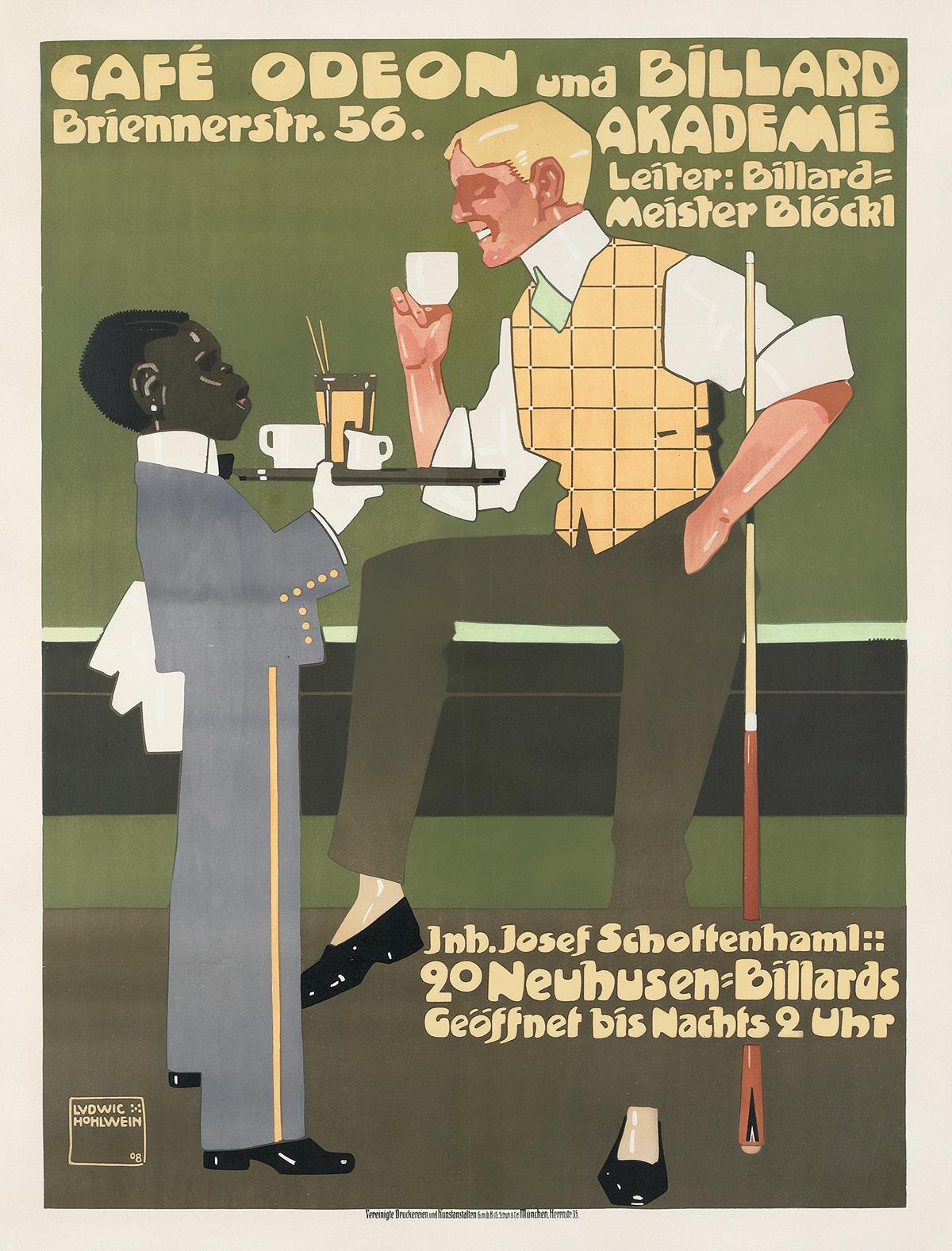
LUDWIG HOHLWEIN
Café Odeon und Billard Akademie. 1908. In his classic poster for the Café Odeon—which also served as Munich’s leading and most fashionable pool hall at the time—a sportily attired billiards player receives a drink from a liveried black waiter. Note the use of the vertical and horizontal lines: the cue stick and the piping on the waiter’s trousers are exactly parallel, and so is the tray and the baize surface of the pool table. And of course, the checkered pattern on the man’s vest reinforces the dominance of right angles.
Est: $14,000-$17,000
Further highlights: Riquet Pralinen, Besuchet den Tiergarten, Hermann Scherrer / Sporting-Tailor, and Hermann Scherrer / Breechesmaker
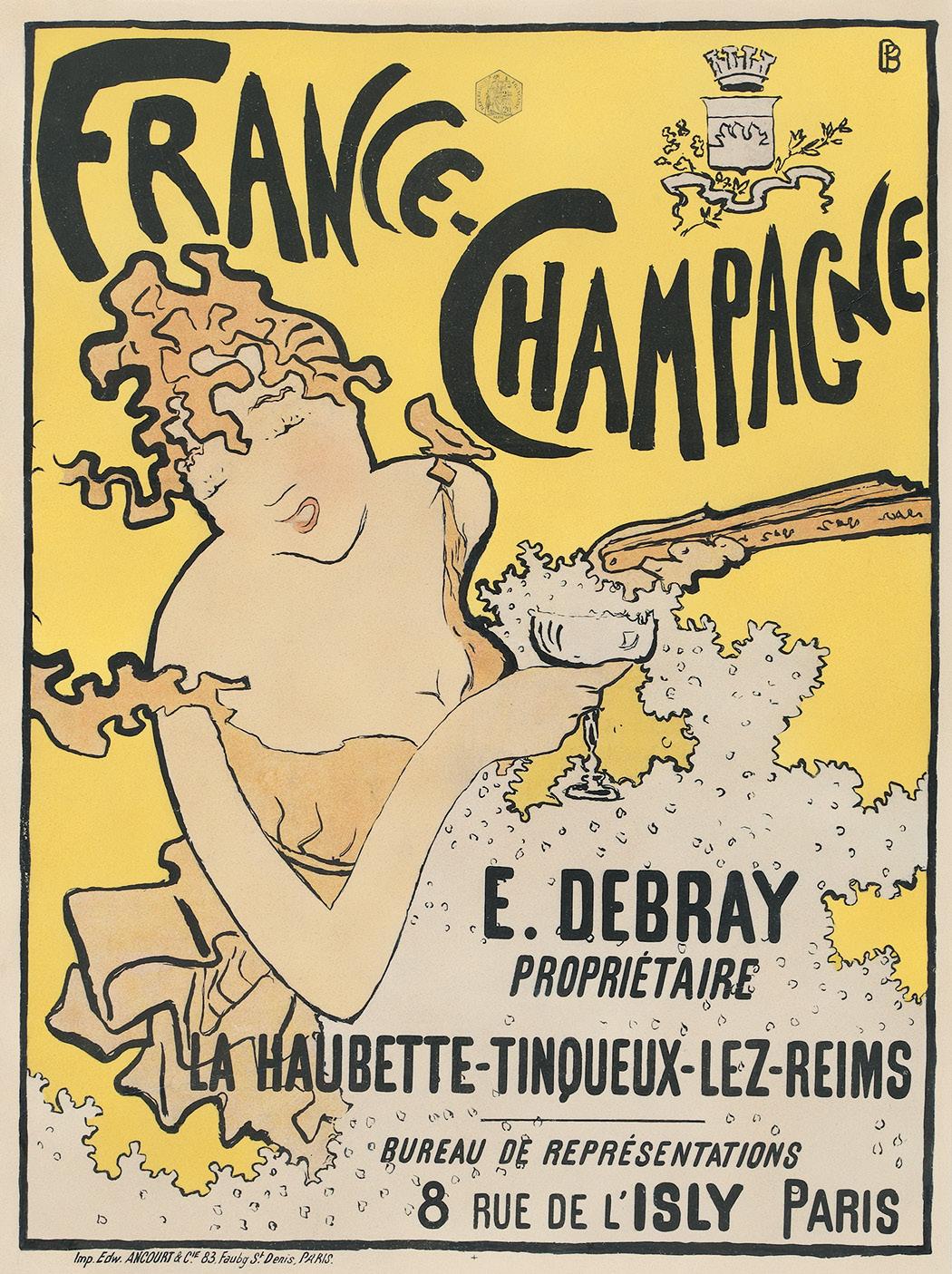
PIERRE BONNARD
France-Champagne. 1891.
“Bonnard was just 24 when he made his first foray into lithography and poster design, but his initial effort, France-Champagne, was a stunning success. The great poster connoisseur, Maindron, immediately called it ‘one of the most interesting works to be seen on the walls of Paris.’ It created a marked contrast to Chéret’s colorful fairyland: it was sparse and subtle, making the most of a few strokes of black against a muted yellow and pink background, with ingenious composition and fluid lettering” (Wine Spectator, 57).
Jane Abdy adds this interesting note: “Toulouse-Lautrec so admired it in the hoardings that he sought an introduction to Bonnard, and the two artists were intrigued by each other’s talents. Bonnard took Toulouse-Lautrec to Ancourt, his printers” (Abdy, p. 90).
Est: $25,000-$30,000
Further highlights: Salon des Cent and L’Estampe et l’Affiche
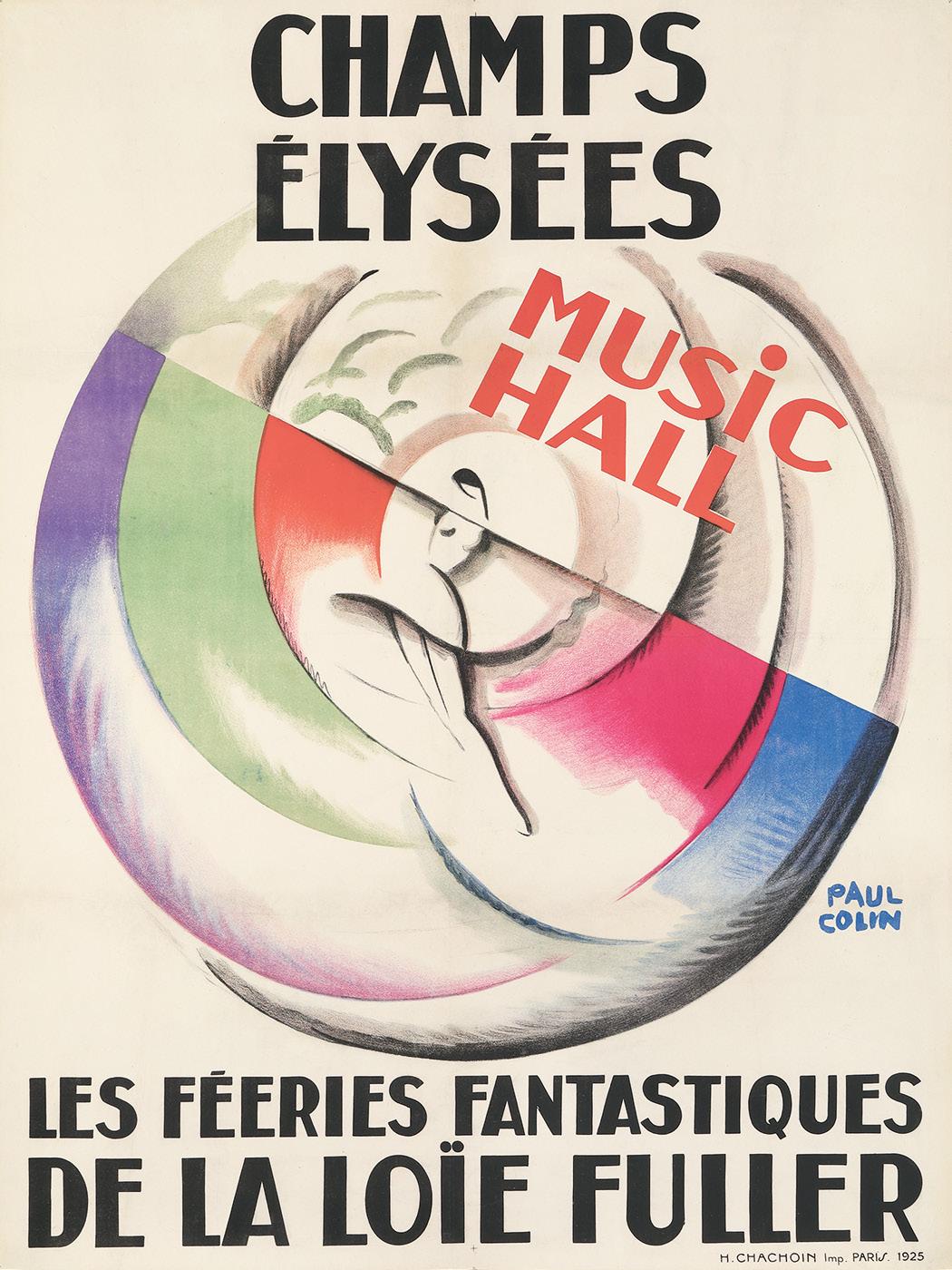
PAUL COLIN
Champs Élysées / La Loïe Fuller. 1925. “When [Loïe] came to the Champs-Élysées… she was 63 years old. ‘Old, but still very interesting,’ recalls Colin… It was her use of lighting effects and wind machines and other devices, all of which she devised herself in her own laboratory, that turned her appearance into a spectacular, ‘psychedelic’ light-and-motion show… And how successfully Colin has caught the swirling rotating motion of the dancer with this circular design. To hold up this poster to the Loïe Fuller designs of Chéret, Lautrec, Orazi, and others, is to gain an instant lesson in the history and progress of the poster and to appreciate the fact that Colin ranks with equal stature with these luminaries of the medium” (Colin, p. 7-8).
Est: $30,000-$40,000
Further highlights: Mitty Tillio et Ricaux, L’Ennemi dans le Sang, Monsavon, and André Renaud
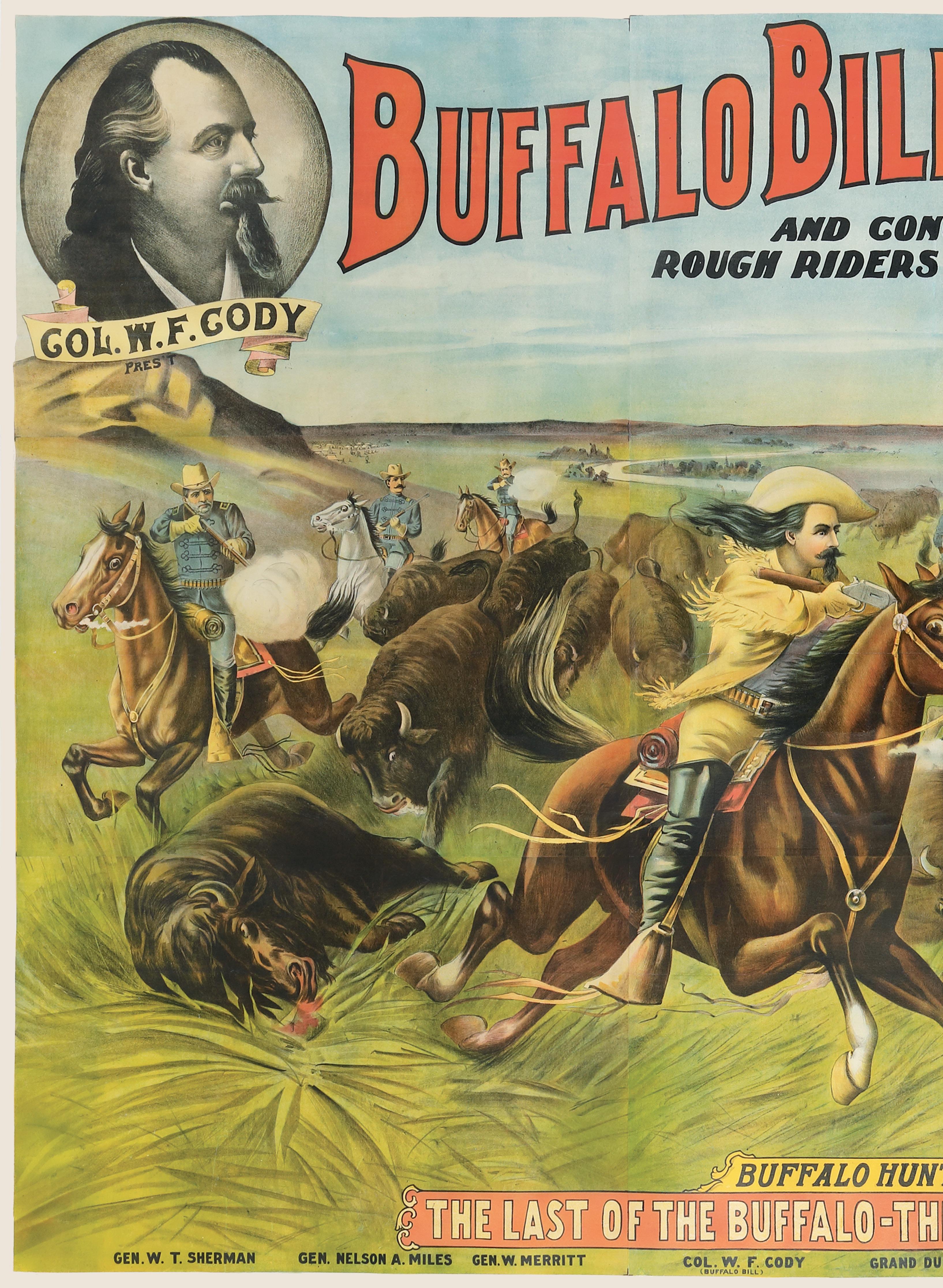
BUFFALO BILL
Buffalo Bill / The Last of the Buffalo. Cody was by no means the first to use large billboards, but there is no question that he did the most to popularize them, and these billboards reached their height (and length) when advertising the Wild West. This six-sheet, 10 foot-wide poster recreates Buffalo Bill’s scouting days and features the military heroes for whom he worked, all identified in the bottom text. Est: $40,000-$50,000
Further highlights: Indian Canoe Scene, Mounted Warriors, and a rare portrait
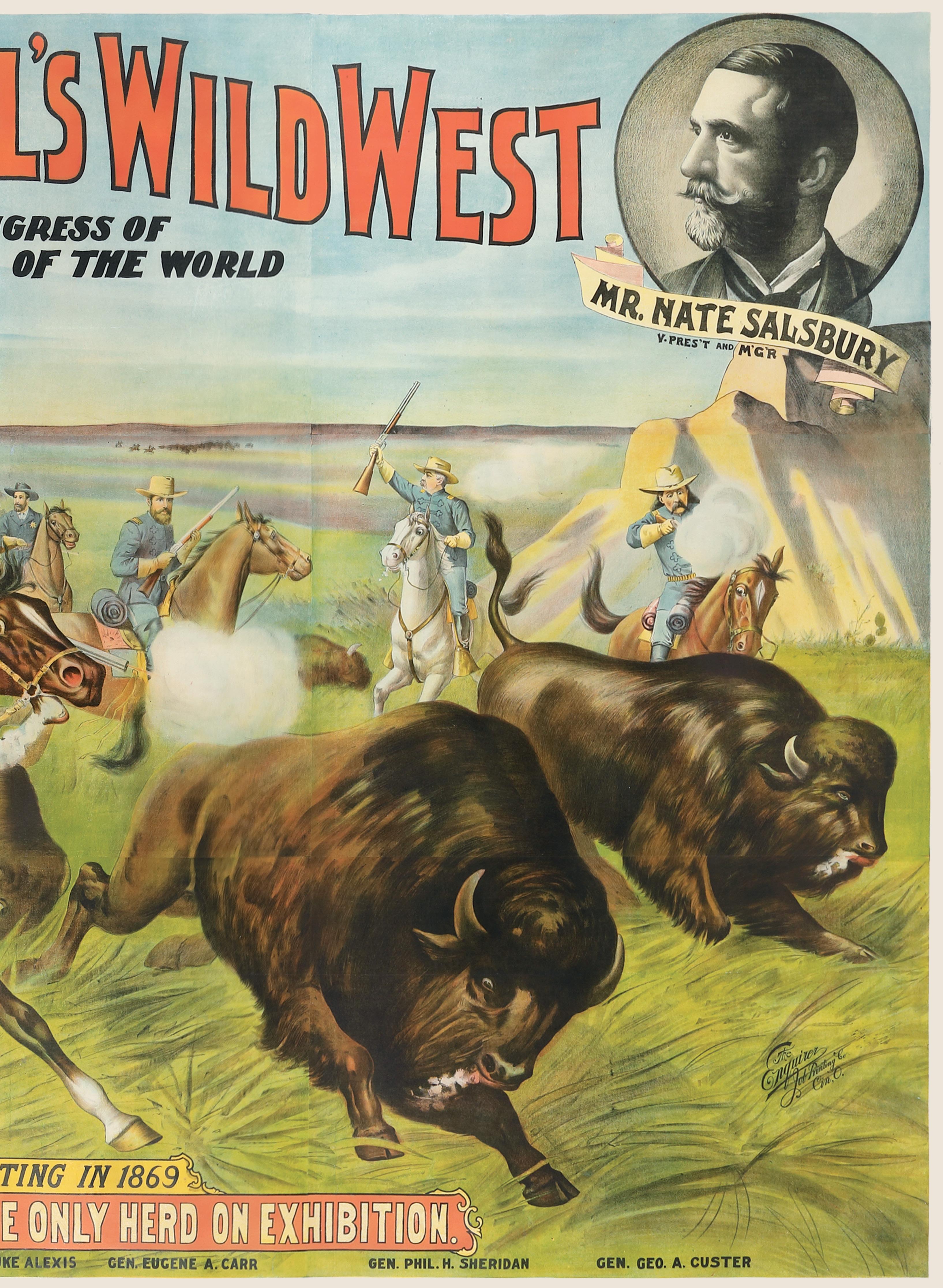
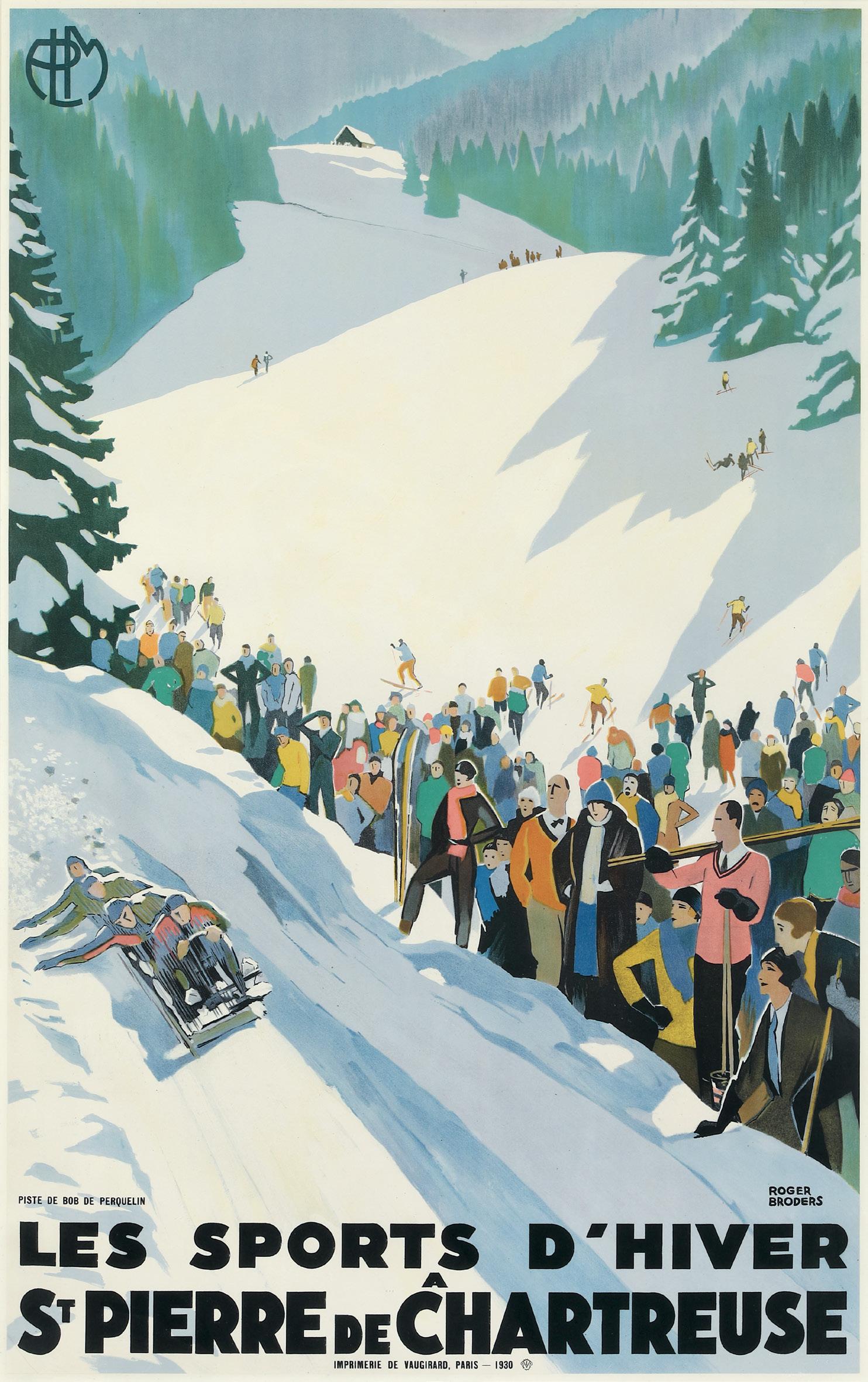
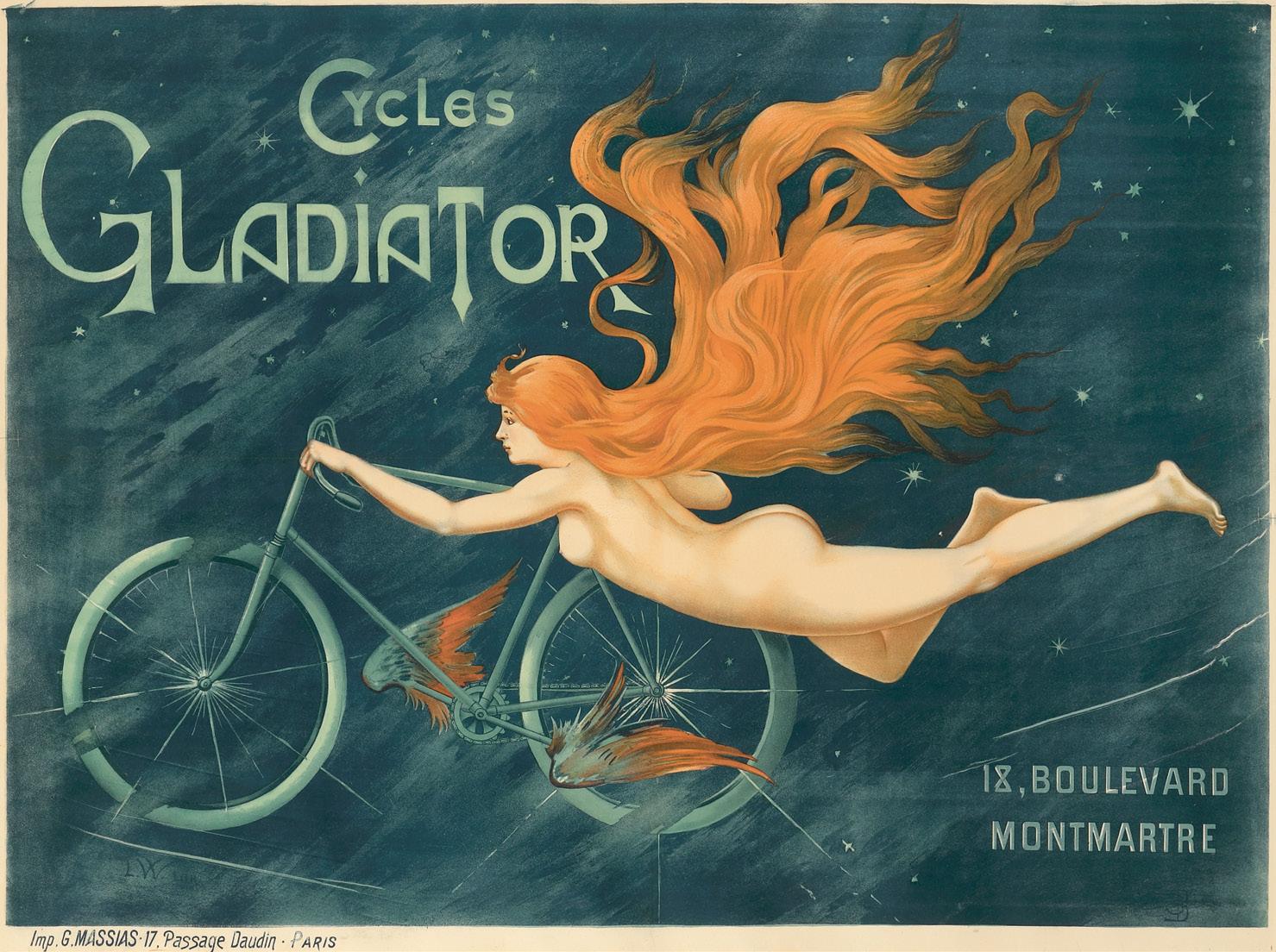
BICYCLES
Cycles Gladiator. ca. 1895. This design is a lithographic masterpiece. Acclaimed as one of the world’s greatest posters, this image of a flame-tressed sylph, propelled among the stars by the Gladiator and its winged pedals, has been appropriated throughout culture ever since its debut in 1895. Shockingly, it remains anonymous, despite the presence of the faint initials LW in the lower right corner. Even in the famed 1896 Reims exhibition, it was attributed to “Anonyme.”
Est: $40,000-$50,000
Further highlights: Pal’s Phébus and Grasset’s Marque Georges Richard
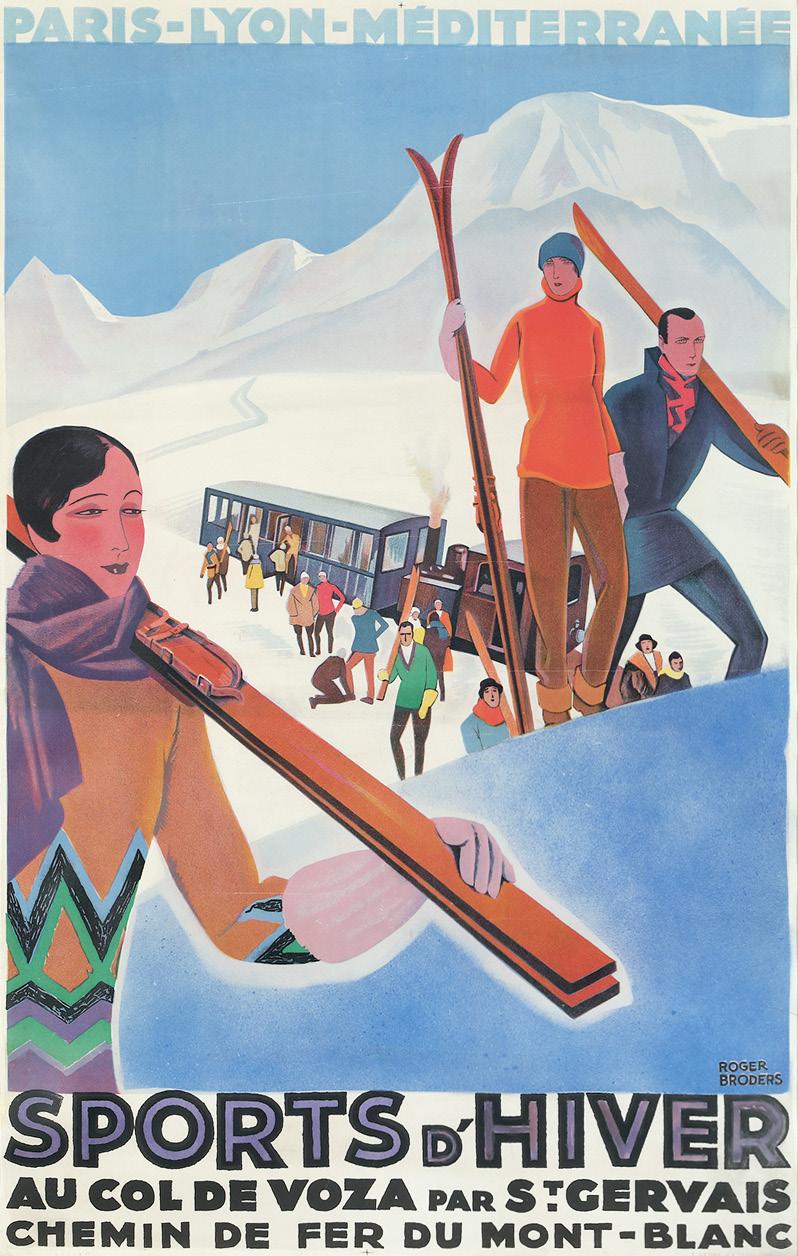
ROGER BRODERS
Les Sports d’Hiver. 1930.
In one of Broders’ most snapshot-esque designs, we are situated in the best spot possible to watch a team of amateur bobsledders whizzing around the bend. Not a single member of the crowd is the same—some lean forward, mouths agape with excitement, while others rest casually on their skis. It’s a testament to the surprising popularity of bobsledding amongst tourists at St. Pierre de Chartreuse, easily reached by PLM rail.
Est: $7,000-$9,000
Further highlights : Agay and La Plage de Calvi. Corse
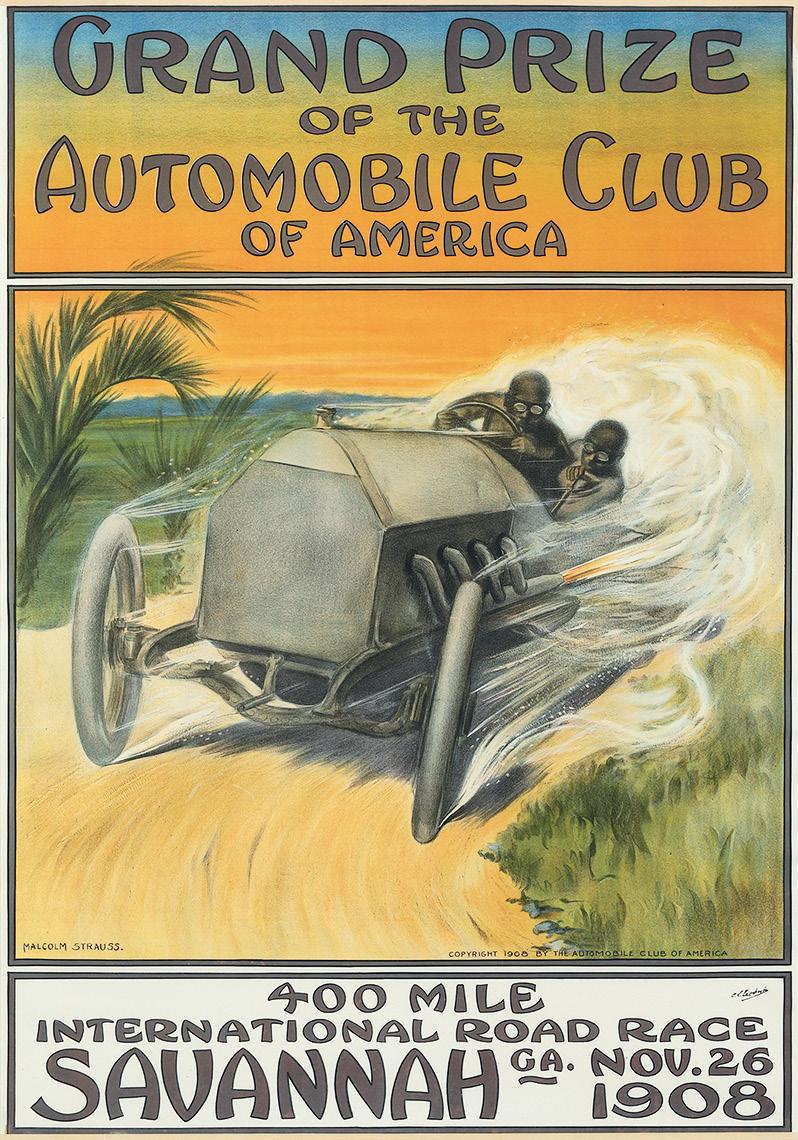
AUTOMOBILES
Automobile Club of America. 1908. This poster for the 400-mile Grand Prix in Savannah, Georgia in 1908 is arguably the rarest and finest of all early American racing posters. It’s a most powerful image, showing the driver and mechanic on the open road at dawn amidst the palmettos, with the wheels and front exhaust spewing out a cloud of smoke, fumes, sparks, and dust. It must have been hellish—but it looks very glamourous.
Est: $8,000-$10,000
Further highlights: Tsas’ Coupe Pilette and Béhel’s Georges Richard / “Unic”
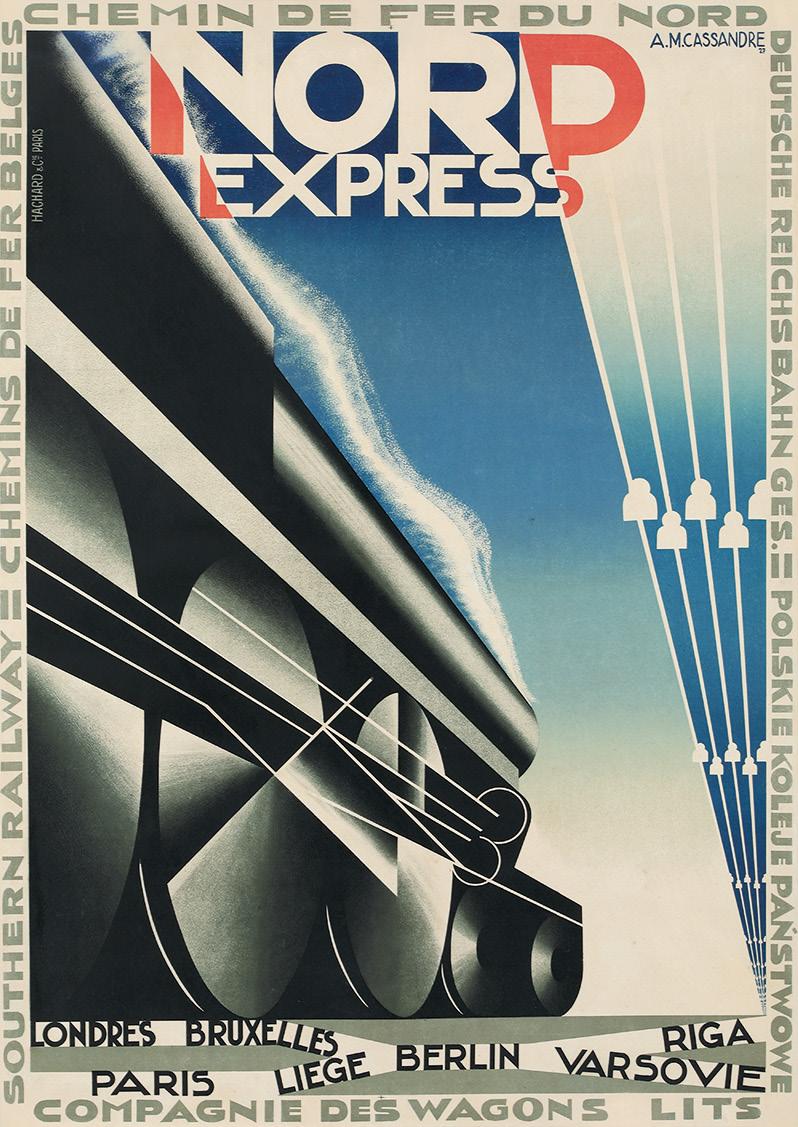
A. M. CASSANDRE
Nord Express. 1927.
In this magnificent poster, Cassandre perfectly portrays the two most important factors in early rail travel: romance and speed. Our eyes are both focused on the geometric whirl of the wheels and the seemingly endless far-off horizon. The size and power of the engine is so brilliantly executed that one can almost feel that solid wall of hot air hitting you as it races by.
Est: $14,000-$17,000
Further highlights: Chemin de Fer du Nord
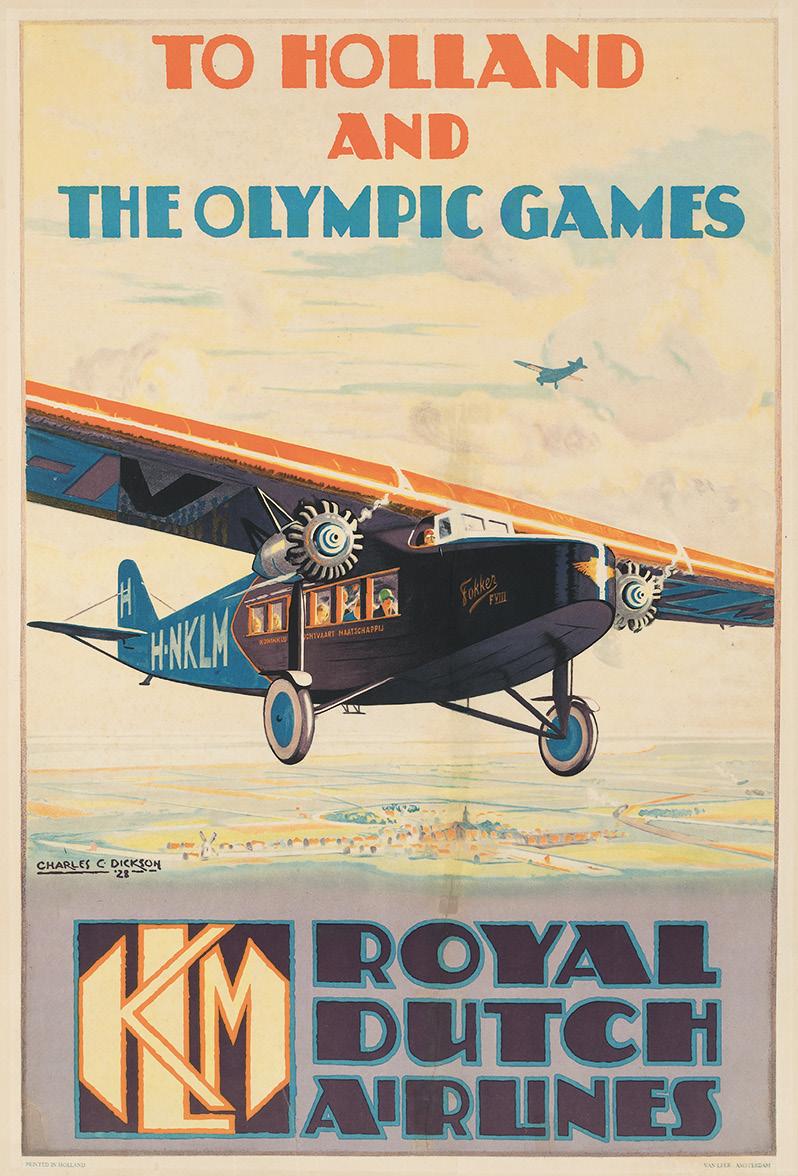
AVIATION
KLM / Royal Dutch Airlines. 1928. KLM announces flights to the 1928 Olympic Games in Amsterdam with this bold design centered on the newly developed Fokker F.VIII. Designed for English-speaking audiences by British artist Charles Dickson, the main goal of this image was to entice Londoners to the Games; in fact, the London-Amsterdam route was incredibly popular, and KLM had to increase service to meet demand. And in terms of the Games, this year saw the introduction of the now iconic Olympic Flame.
Est: $2,500-$3,000
Further highlights: Two early images of Farman and Latham, Klein’s Fly TWA Jets / Paris, and Jacquelin’s Aéropostale / Au Maroc Par Avion
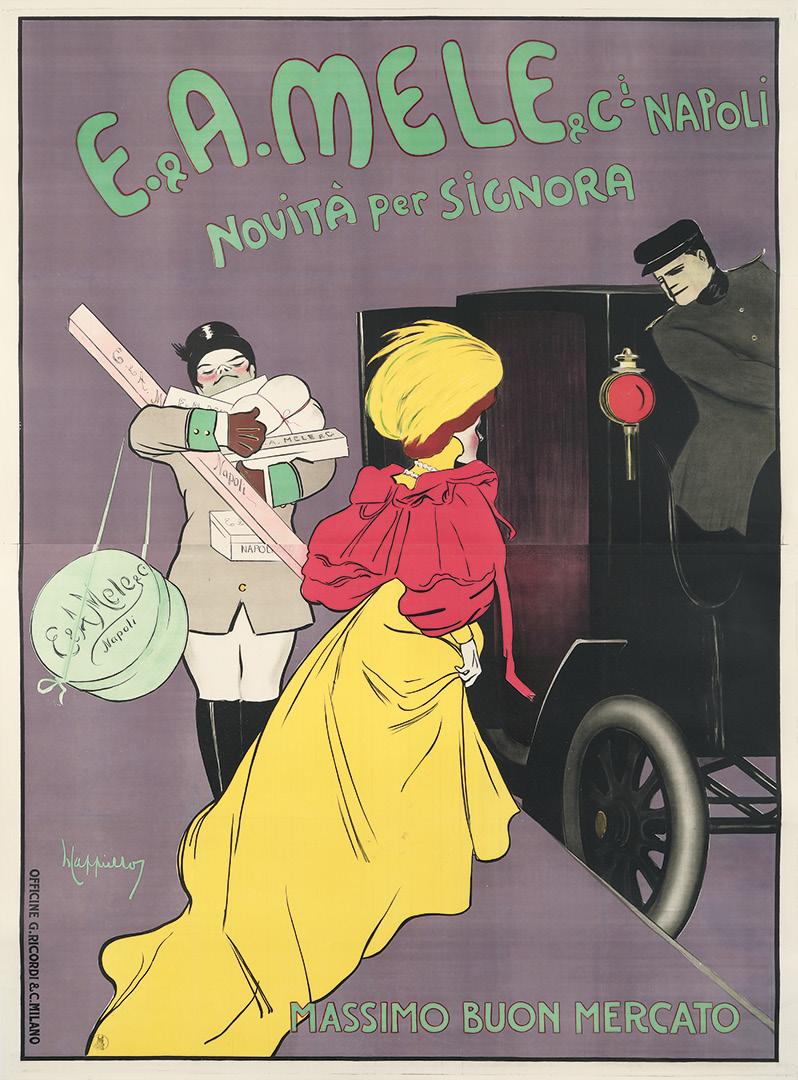
LEONETTO CAPPIELLO
Mele. 1907.
The last of many designs Cappiello created for the department store, he captures the end of a successful shopping trip. The lady, not even bothering to look back, is about to hop into a cab as her driver leans forward to make sure she’s seated before he departs. Behind her, a snooty yet overloaded footman carries a bevy of carefully wrapped parcels, all displaying the Mele logo. Rather than show a particular item, we can imagine anything our hearts desire within those packages. It’s a truly ideal shopping spree.
Est: $17,000-$20,000
Further highlights: Produits Otto, ParapluieRevel, the largest format Chocolat Klaus, a never-before-seen screen for Galeries Lafayette, and Remington (cover)
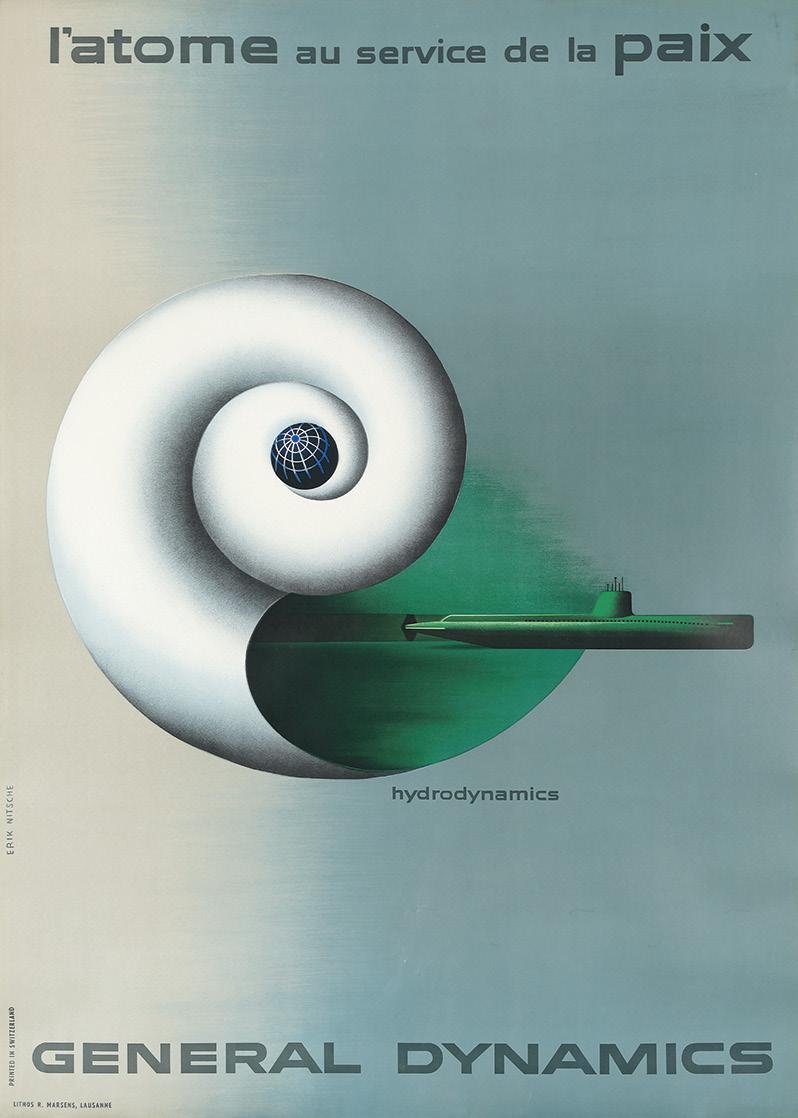
MODERN
General Dynamics / Hydrodynamics. 1955. Possibly the most famous image in the series, “It was an indelible logo in its day... the shell was a virtual cornucopia of progress” (I Heart Design, p. 55). “The symbol of our progress is the great atomic submarine ‘Nautilus,’” General Dynamics’ CEO said, downplaying the global nuclear strategy of which submarines were a part. The text is in French, in homage to Jules Verne’s “Twenty Thousand Leagues Under the Sea,” from which the Nautilus is named. The USS Nautilus (SSN-571) is a National Historic Landmark permanently berthed as a museum in Groton, Connecticut.
Est: $4,000-$5,000
Further highlights: Fix-Masseau’s 1951 Philips, five designs by Haring, and Warhol’s Perrier
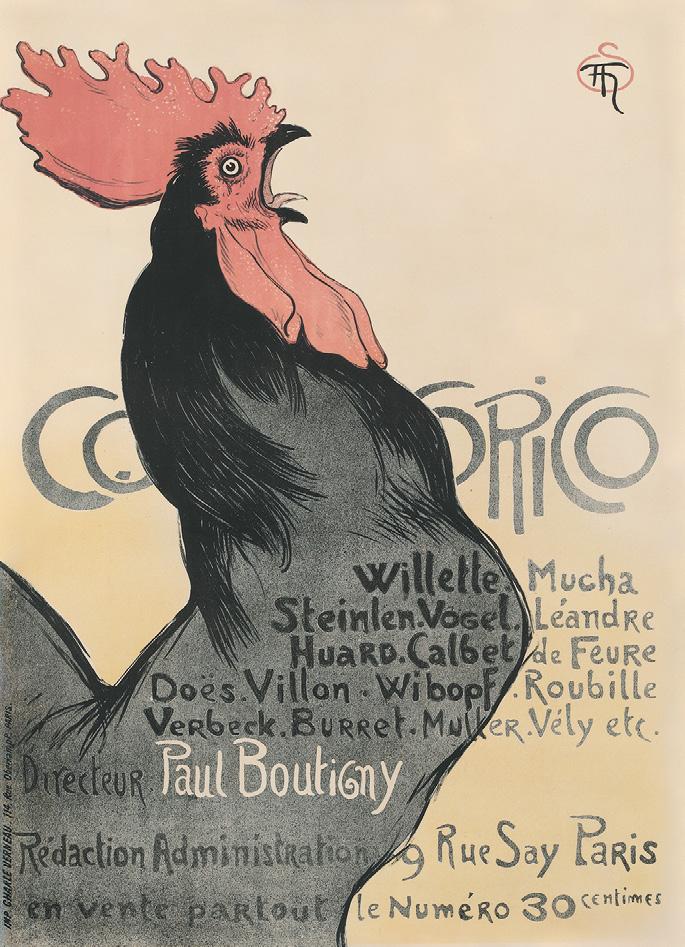
T. A. STEINLEN
Cocorico. 1899.
The word “Cocorico” is the French equivalent of “cock-a-doodle-doo,” making it rather unnecessary to show the entire word as the rooster says enough. The publication did much to encourage fine poster design by reproducing posters, selling them in its pages, and illustrating the works of major poster artists. This is Steinlen’s most forceful poster.
Est: $20,000-$25,000
Further highlights: Chat Noir, A la Bodiniére / Exposition, Mothu et Doria, and La Traite des Blanches
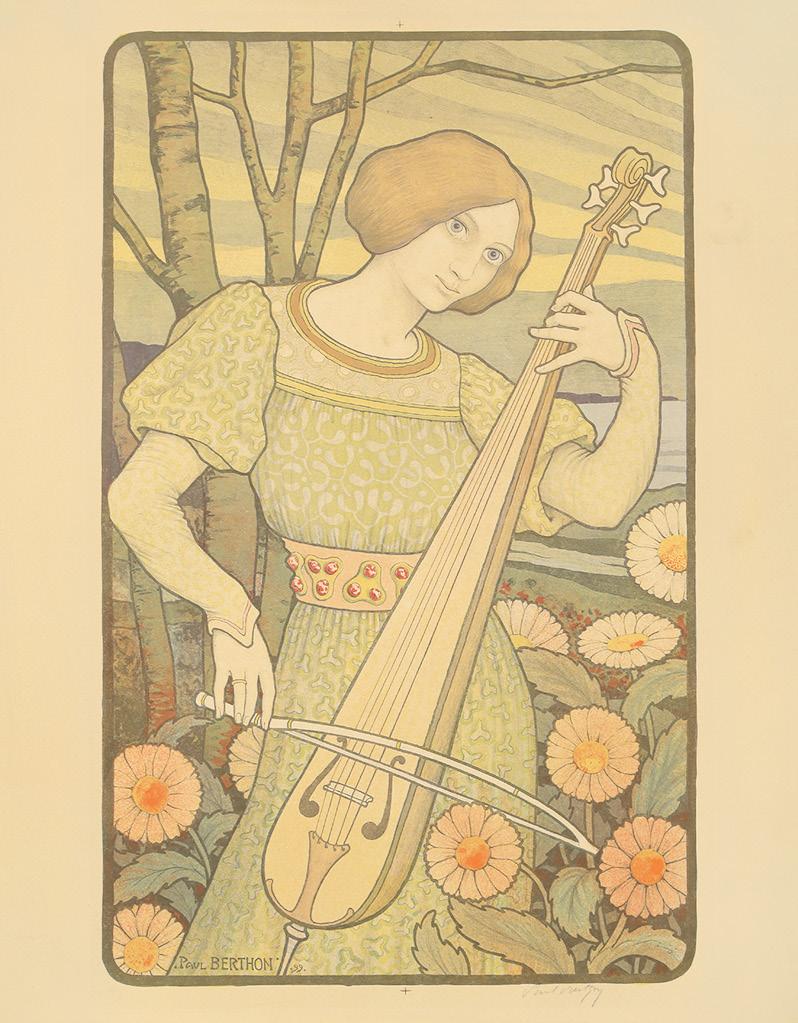
PAUL BERTHON
La Viole de Gambe. 1899. “Gabriel Mourey, writing in The Studio illustrated La Viole and commented: ‘It may perhaps be urged against this artist that he is somewhat too much under the influence of M. Grasset, an influence from which, it must be remarked, decorative draughtsmen do not take sufficient care to escape. Nevertheless, M. Paul Berthon has an exquisite sense of line and colour, and he seems to attach more importance to expression than does his master” (Berthon & Grasset, p. 104 & 114). This decorative panel is hand-signed by the artist.
Est: $2,000-$2,500
Further highlights: Concert Mistique, Sarah Bernhardt, and Mai
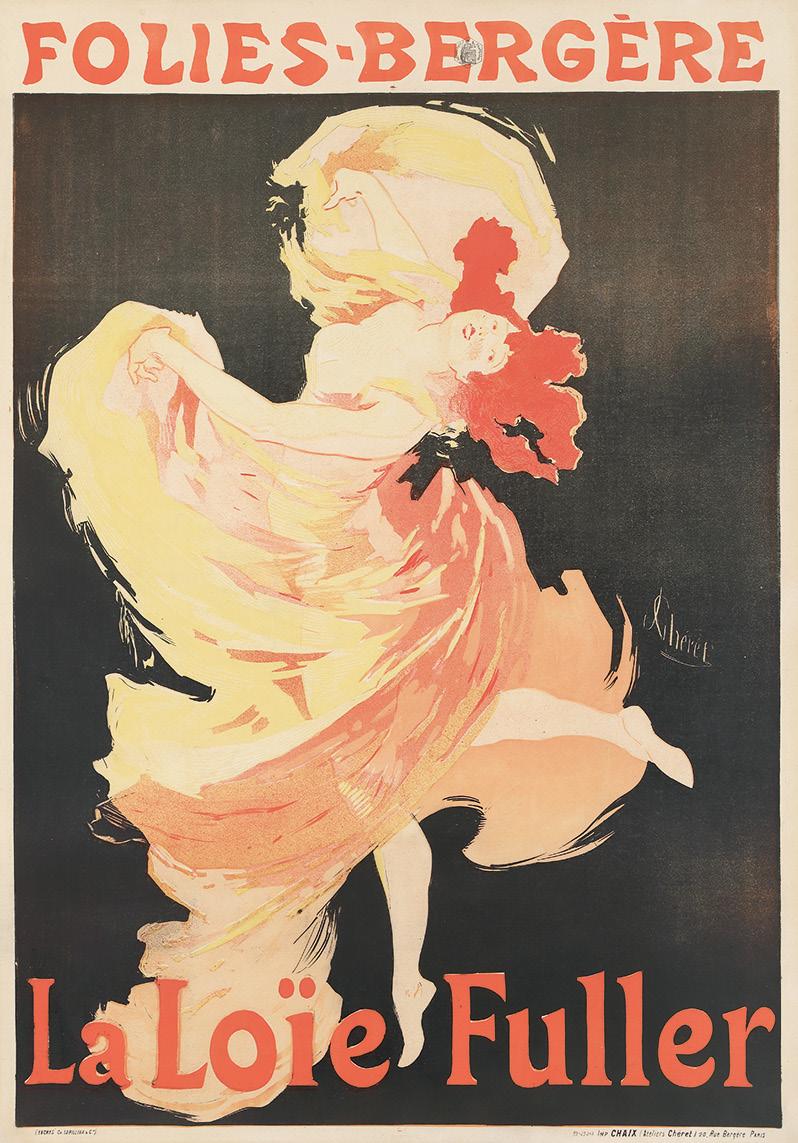
JULES CHÉRET
Folies-Bergère / La Loïe Fuller. 1893. The ethereal performer Loïe Fuller commissioned and paid for many lithographic posters for her performances, and this one from Chéret lives on in infamy. The editor of The Poster wrote in 1899, “With excellent judgment she went to Chéret —Chéret the master of gorgeous and fantastic color—to herald her earlier performances in that metropolis to the gaiety of which his posters have added so materially... In his long career as an affichiste , Chéret has produced nothing more successful than his series of designs for Loïe Fuller” (Loïe Fuller/Current, p. 129).
Est: $5,000-$6,000
Further highlights: Pastilles Géraudel, Palais de Glace, Libraire Ed. Sagot, and five paintings

WAR & PROPAGANDA
Get in the Game. 1917. What’s more American than Uncle Sam playing baseball? Leyendecker pulls out all the patriotic stops to get Americans involved in the war effort.
Est: $2,000-$2,500
Further highlights: Classics by Christy and Flagg, plus a rare image by Ben Shahn
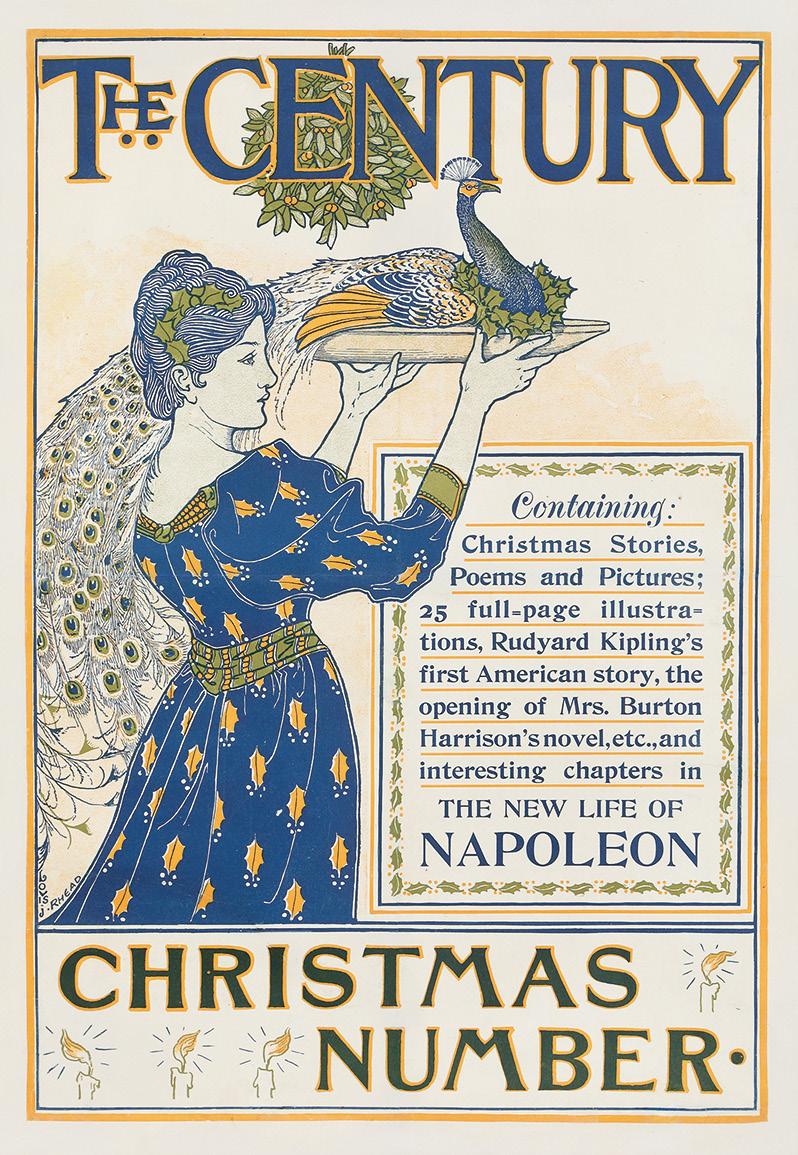
AMERICAN LITERARY
The Century / Christmas Number. 1894. Throughout Europe in the 16th and 17th centuries, it would not be uncommon for the ultra-wealthy to feast upon peacock at Christmas and other special events. That archaic tradition is referenced in this elegant poster by Rhead promoting The Century’s Christmas number, featuring “poems and pictures, 25 full-page illustrations, Rudyard Kipling’s first American story [and] the new life of Napoleon.” This is the smaller format version of the design.
Est: $1,400-$1,700
Further highlights: Several Penfield designs for Harper’s and Collier’s plus images from Leyendecker and Rockwell
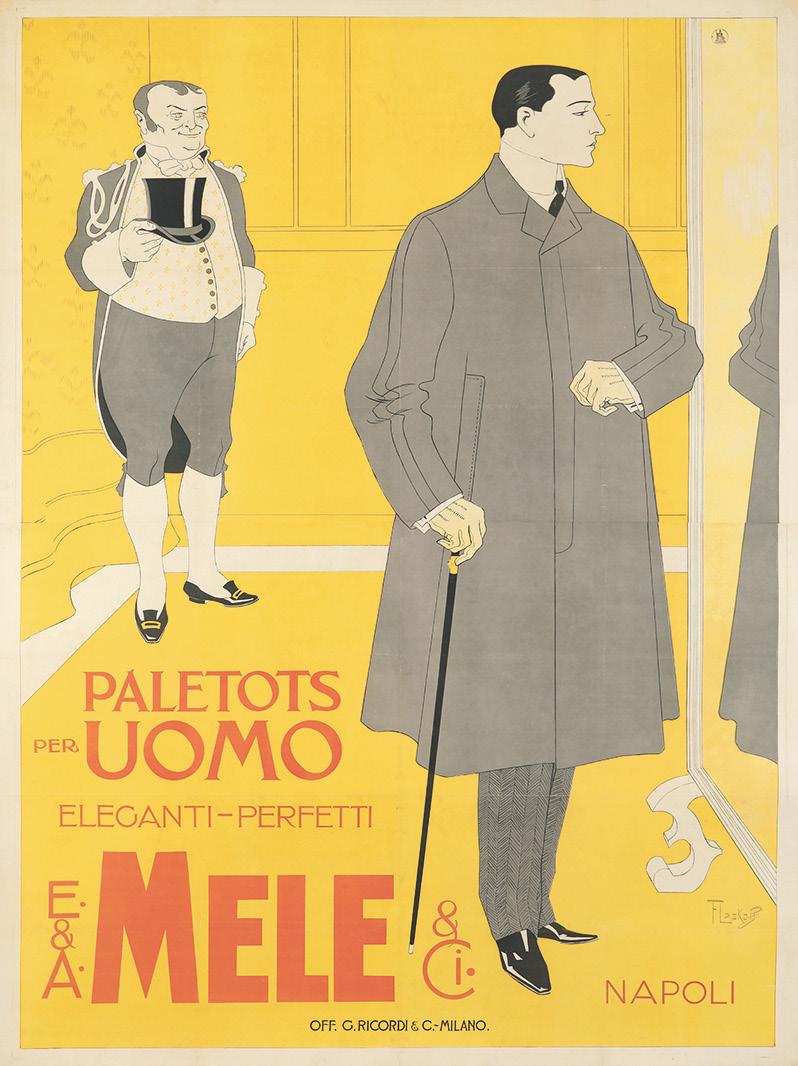
MELE
Mele & Ci. / Paletots per Uomo. 1902. The gentleman is trying on an impeccably tailored coat in somber grey; to offset it, the background is a bright yellow. Without overstating the point, Laskoff sets a scene for Mele of utter elegance and refinement. A portrait painter and landscapist, Laskoff (born Franz Laskowski in Bromberg, Germany) traveled to France, England, and elsewhere, but most of his work was done in the early 1900s in Italy, where he proved that he could match the best graphic artists of his day. He produced about twenty posters, all of them very distinguished, in a style that was uniquely his own.
Est: $6,000-$8,000
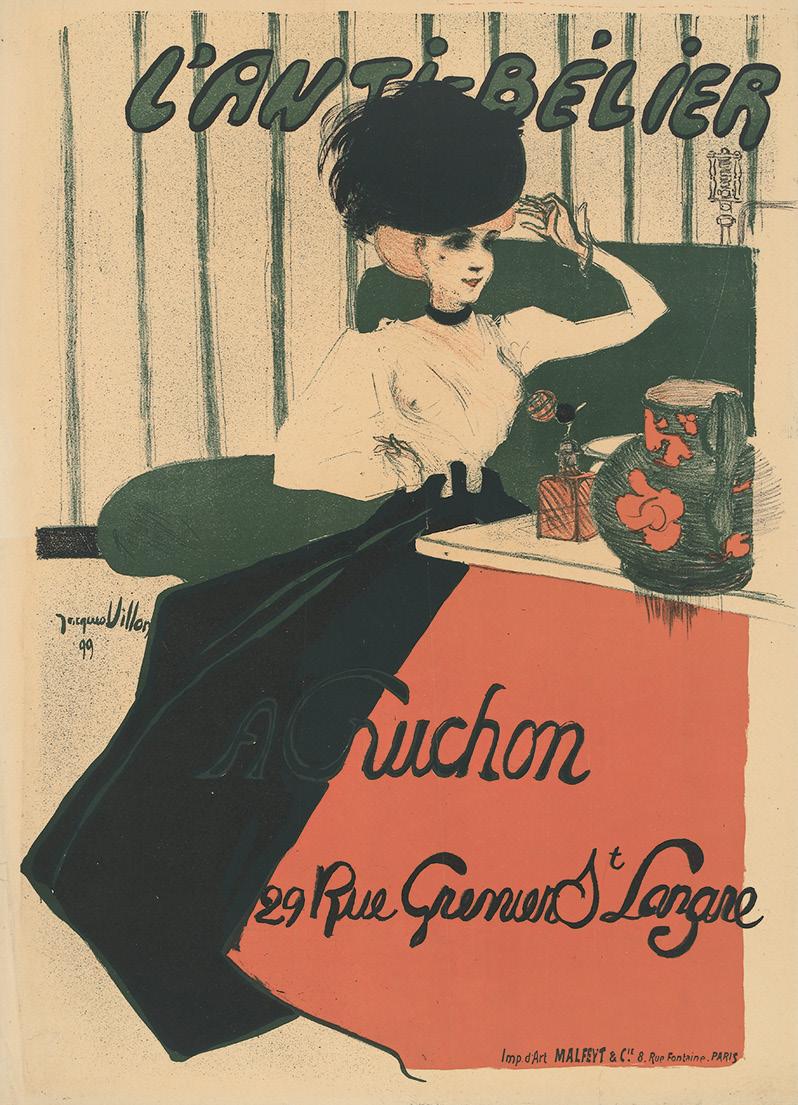
ART NOUVEAU
L’Anti-Bélier / A Cruchon. 1899.
Both an important figure in the history of Modern art as well as a staple of bohemian society at the turn of the century, Villon dabbled in everything from Cubism to illustration to printmaking. Creating only about six posters in his lifetime, they stand out from the rest of his oeuvre, showcasing a graceful drawing style and a sensitive expression of character. In this exceptionally rare image by the artist, we catch an auburn-haired sophisticate in the midst of primping herself. Despite the ambiguous product, the poster itself is simply exquisite, and it’s a gorgeous homage to beauty for beauty’s sake.
Est: $12,000-$15,000
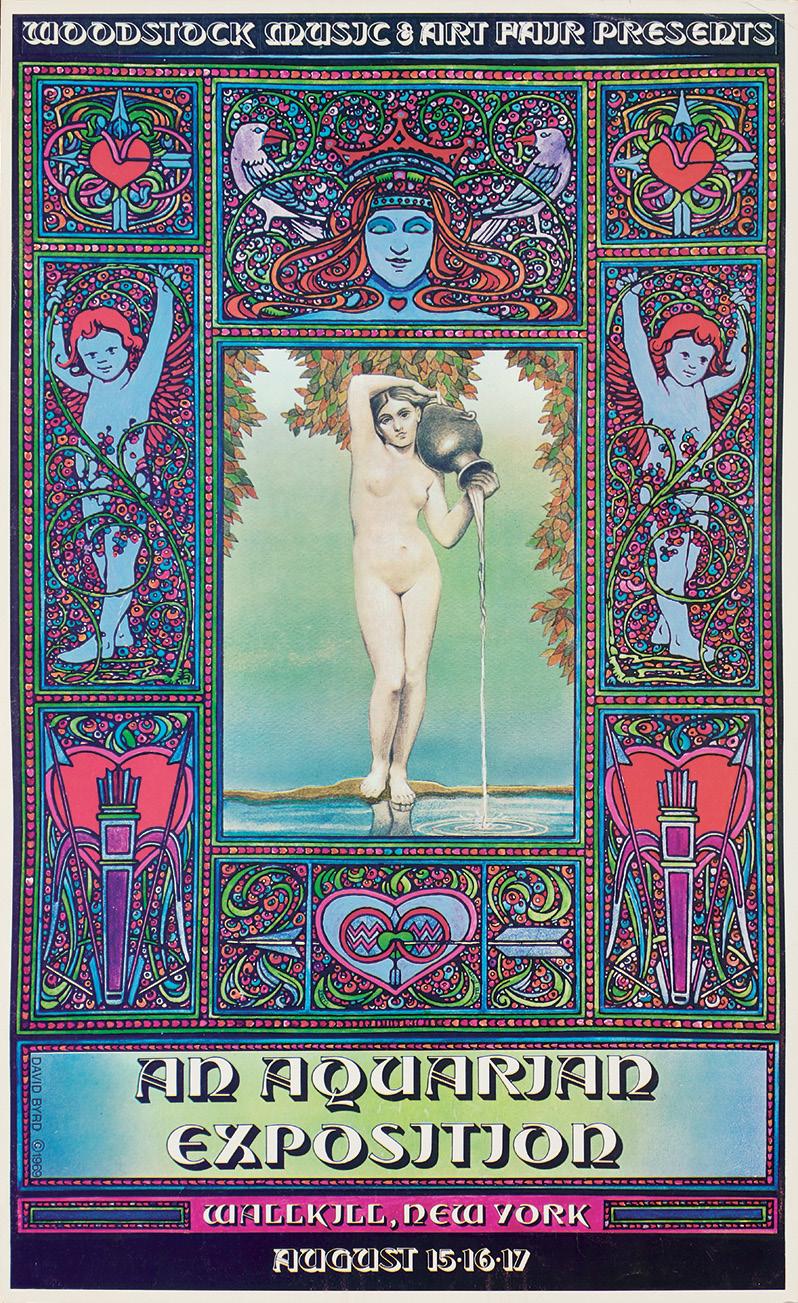
COUNTER-CULTURE
Woodstock Music & Art Fair. 1969. This seldom seen design is the original poster for the Woodstock festival that would go on to become a cultural phenomenon. When the venue was changed from the town of Wallkill to Max Yasgur’s private farm at the last minute, a new poster had to be commissioned to redirect attendees ( see PAI-LXVI, 472). Unfortunately, Byrd had just left for a month-long trip to a remote town in the Caribbean and was unreachable by phone, which left this design to wallow in obscurity despite its far greater artistic merits. But it’s a poignant time to revisit Byrd’s Ingres-inspired design as Woodstock is celebrating its 54th anniversary.
Est: $2,000-$2,500
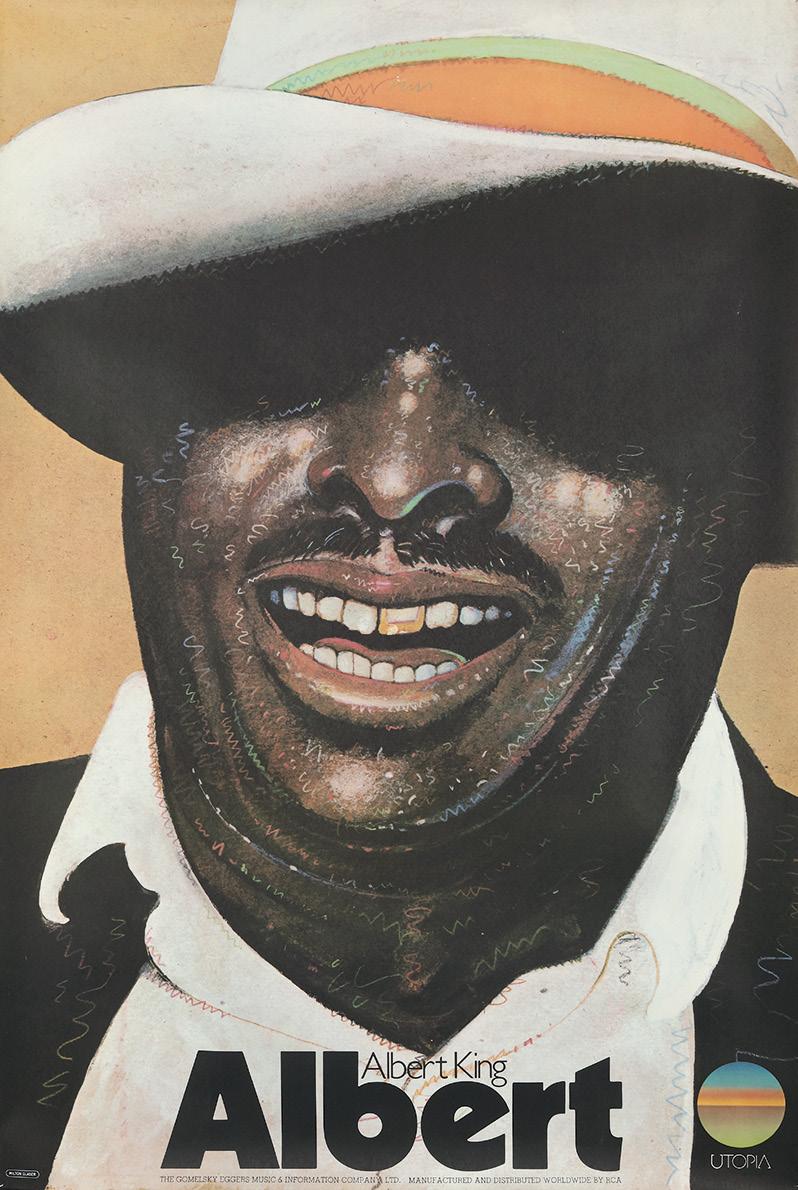
THE BLUES
Albert. 1976. Glaser attempts to portray the “vitality and strength” (Glaser Posters, p. 208) of legendary American blues guitarist Albert King. Born in 1923 in Indianola, Mississippi, King came to fame with his 1967 album, Born Under a Bad Sign . The late 1960s were a fruitful time for King: he performed at Bill Graham’s Fillmore shows, played live with the St. Louis Symphony Orchestra, joined The Doors on stage in Vancouver, and released multiple albums. By 1976, his music veered towards pop and was less successful, but he soon found his way back to his roots of American soul.
Est: $1,000-$1,200
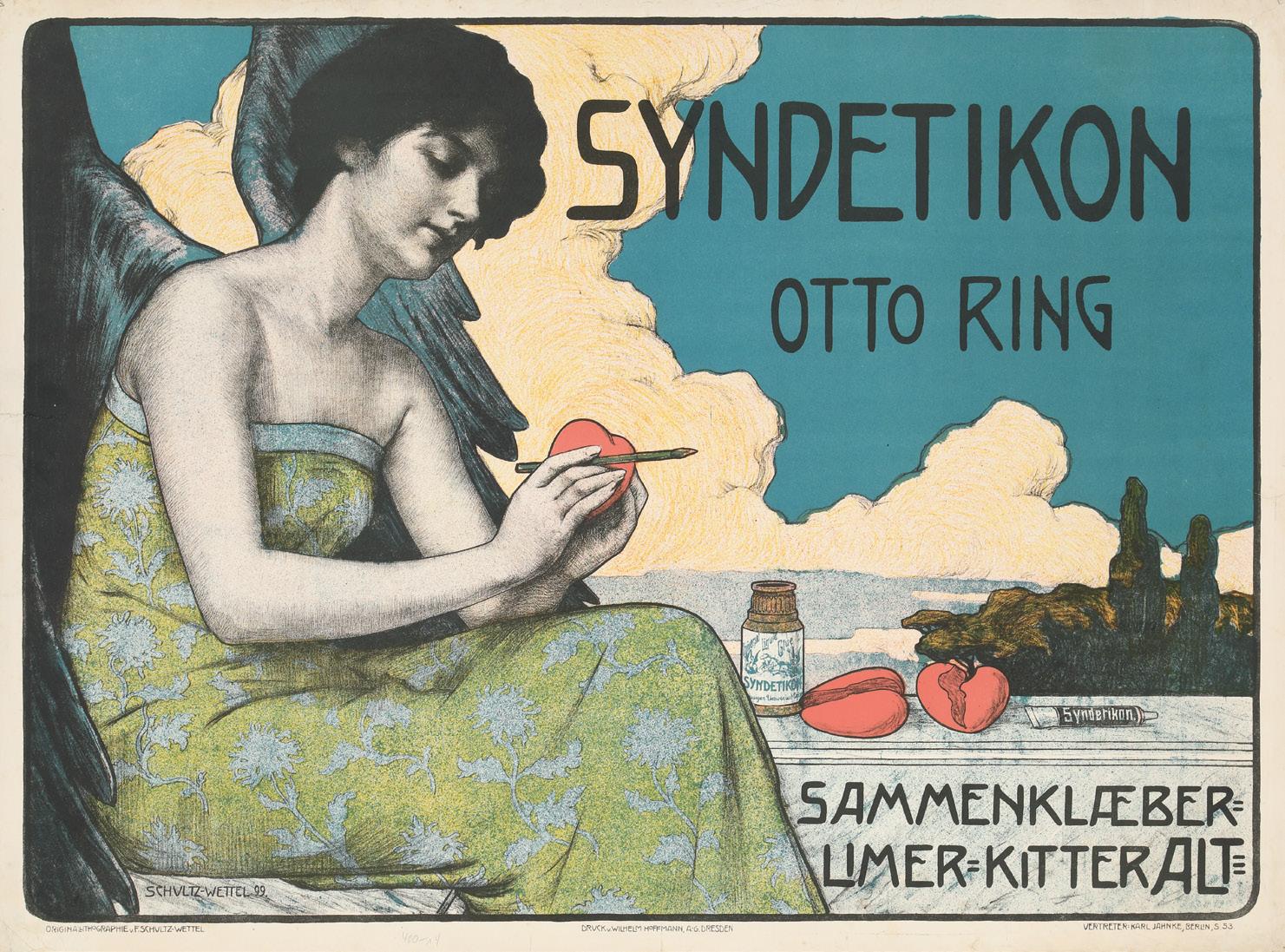
Schultz-Wettel
GERMAN
Syndetikon. 1899.
“Glues everything, even iron” reads the legend; thus a lovely fin-de-siècle angel is calmly using the adhesive to mend broken hearts. It’s a most romantic scene for an incredibly ordinary product.
Est. $2,000-$2,500
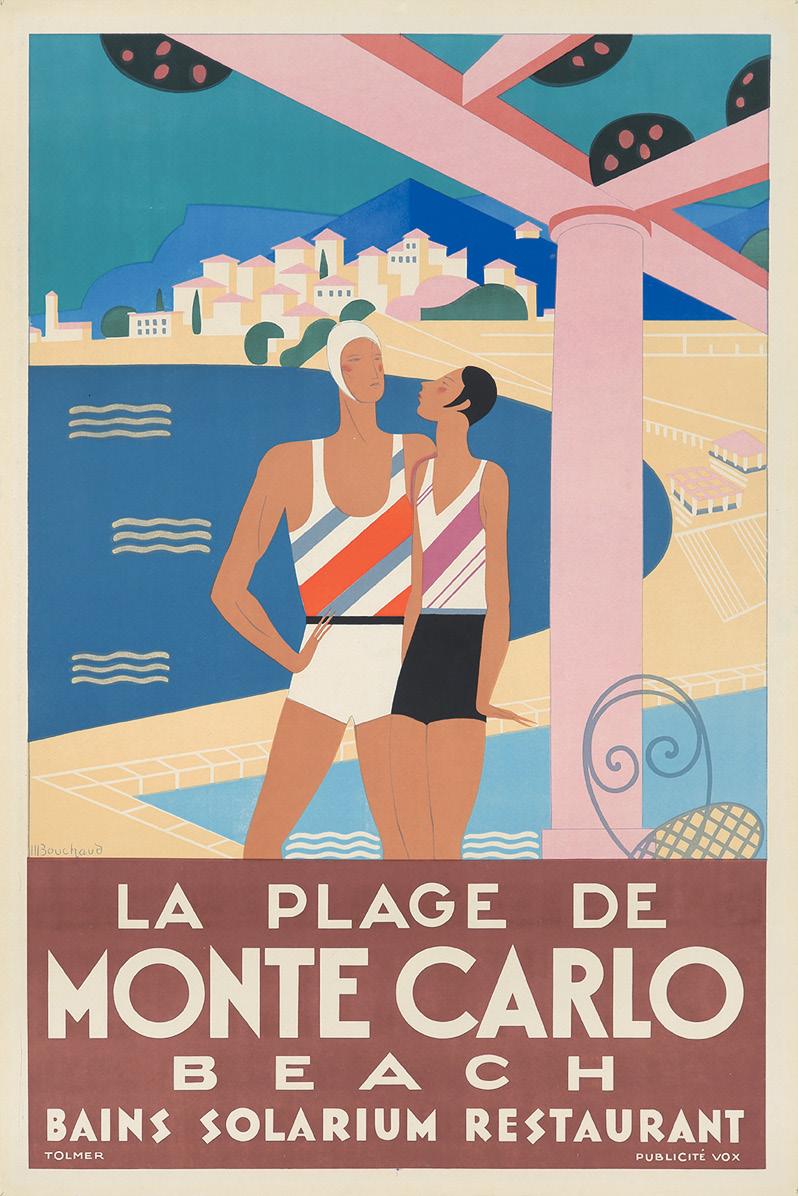
TRAVEL
La Plage de Monte Carlo. 1929. This is one of the best beach scenes in true Art Deco style ever printed. It’s just one of three posters created by Michel Bouchaud. After his military service, he asked to be demobilized in Algeria, where he joined his brother at Villa Abd-el-Tif and discovered the Mediterranean light. Returning to Paris, he worked on behalf of perfumers, chocolatiers, designers, and jewelers. His work normally concentrated on a smaller, more experiential scale: barrels of Rum Négrita, record covers, and the like. The totality of the Art Deco infusion in this poster is redolent of his will to immerse himself in the creative experience.
Est: $8,000-$10,000
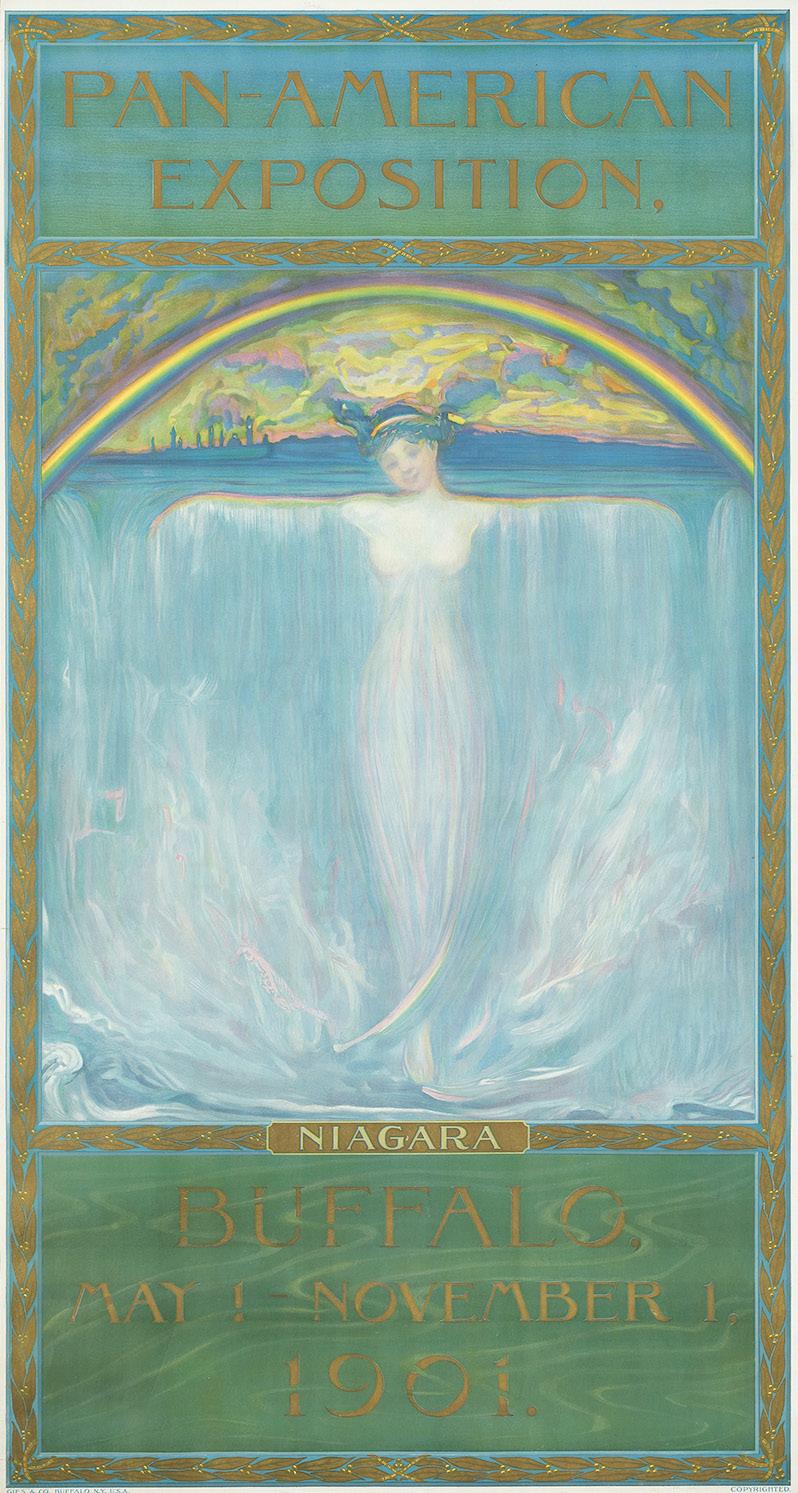
EXPOSITIONS
Pan-American Exposition / Buffalo. 1901. This early and important poster promotes the Pan-American Exposition in Buffalo, New York. The allegorical image brings the origin of the name of the famous waterfall to life: “Niagara” means “Maid of the Mist” in Mohawk. It is an ethereal and dreamy composition in muted twilight hues. Cary contributed only the image for this poster, while the commercial artist Frederic F. Helmer added the gold metallic text and organic border.
Est: $5,000-$6,000
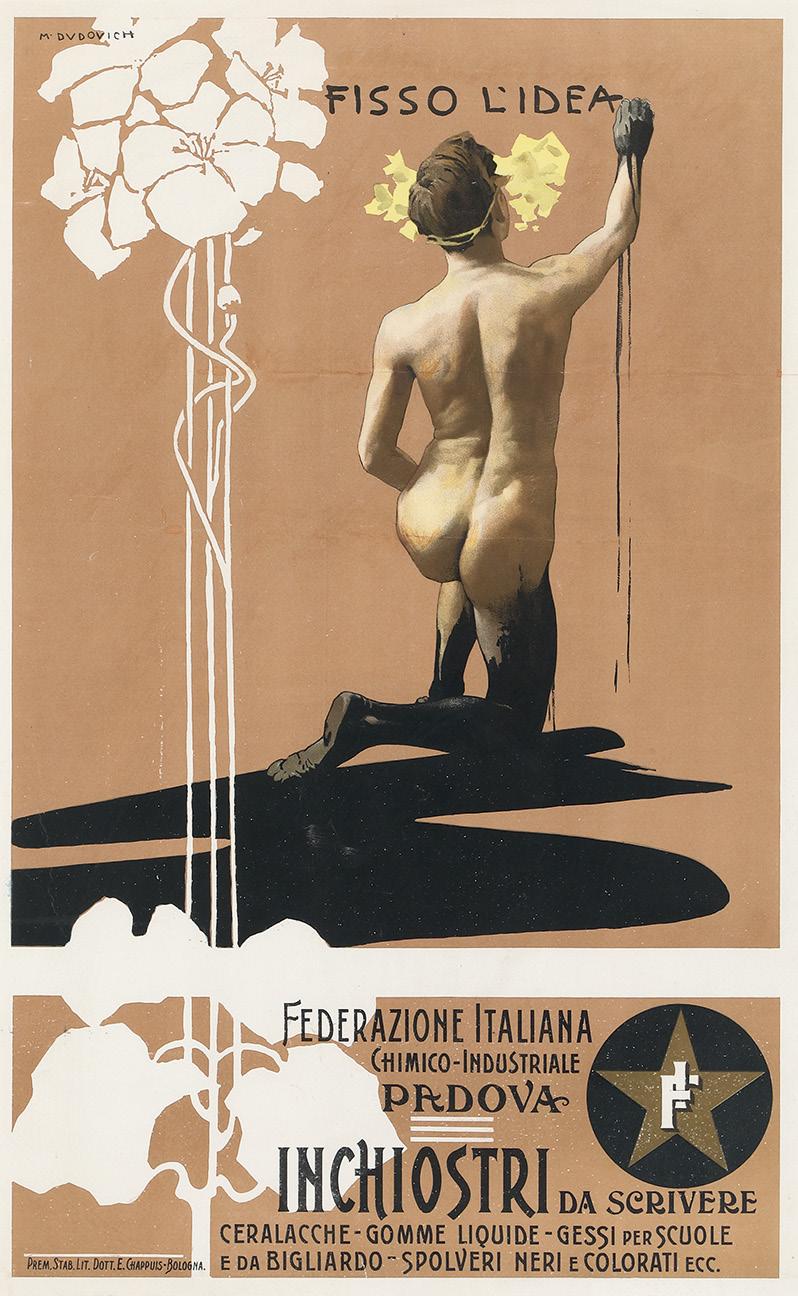
ITALIAN
Inchiostri da Scrivere. ca. 1911. “A fixed idea” is usually just a phrase, but here it takes on a more literal meaning: the Padova firm’s pens and inks are used to “fix” an idea in writing, and therefore preserve it for all time. It’s an original concept from the Italian Art Nouveau master.
Est: $3,000-$4,000
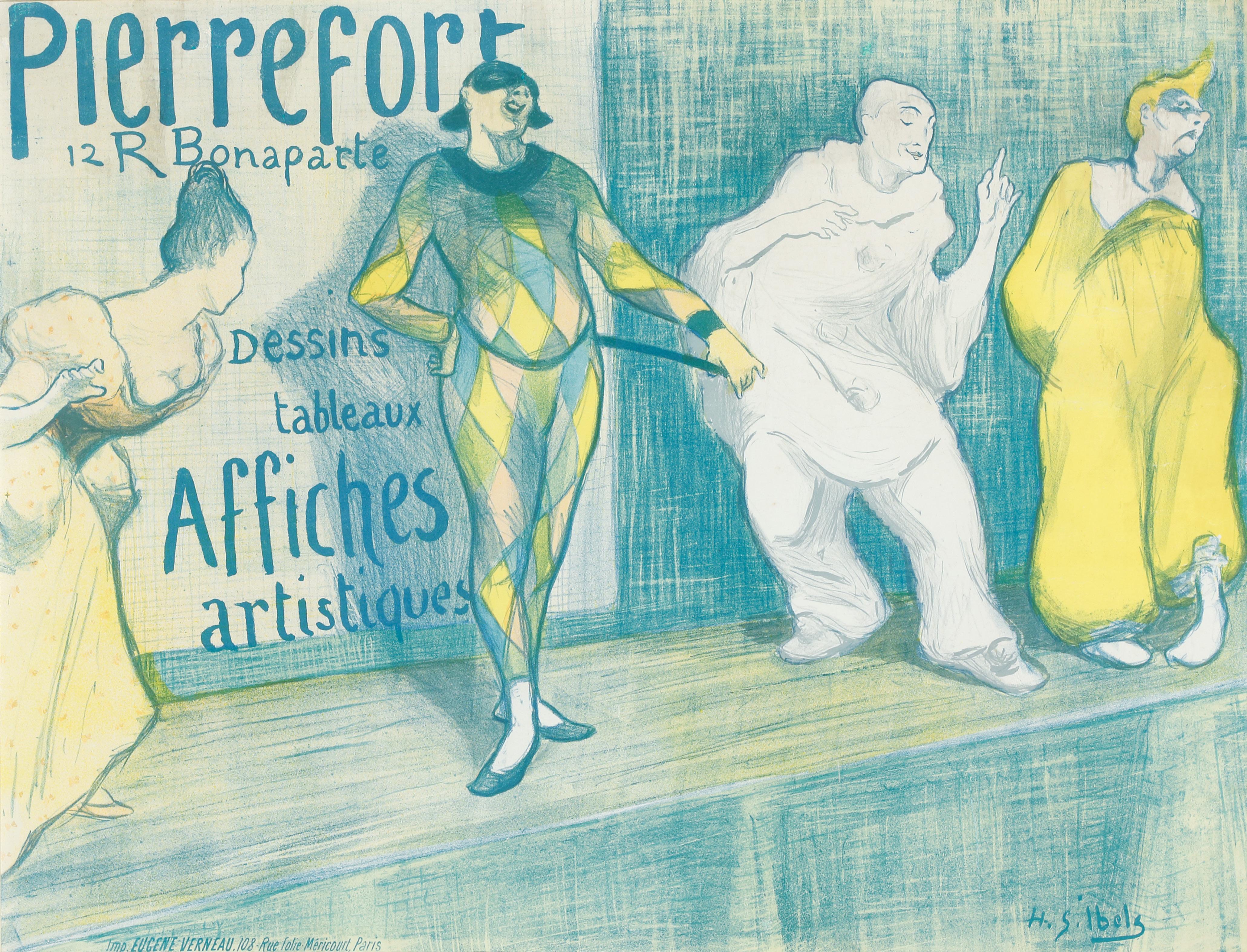
Est: $7,000-$9,000





